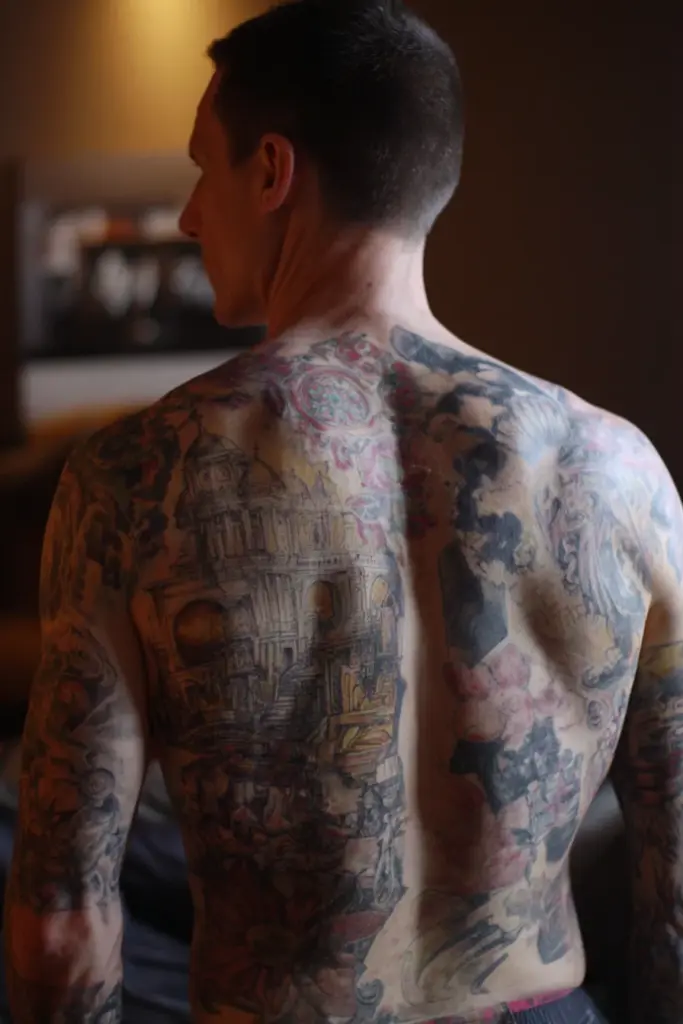Im Hakan — a tattoo consultant and designer with over a decade working in modern tattoo culture. Over the years Ive guided hundreds of clients from concept to healed artwork, and this post collects 32 curated back-tattoo images and ideas tailored for men. Back tattoos are a powerful canvas: they suit men with broad shoulders, athletic builds, those wanting full-back storytelling pieces, and even guys seeking discrete lower-back or shoulder-blade accents. Practical tips I always give: pick a style your chosen artist excels in, test a life-size stencil to check flow and posture, consider how the design interacts with the spine and shoulder blades, plan session length for pain tolerance, and prepare realistic aftercare and budget expectations. Whether you want bold tribal, Japanese, realistic portraits, or minimalist line work, these 32 images will help you visualize size, placement, and long-term wear.
Winged Lion (Griffin) Back Tattoo — Black & Grey Full-Back Design for Men
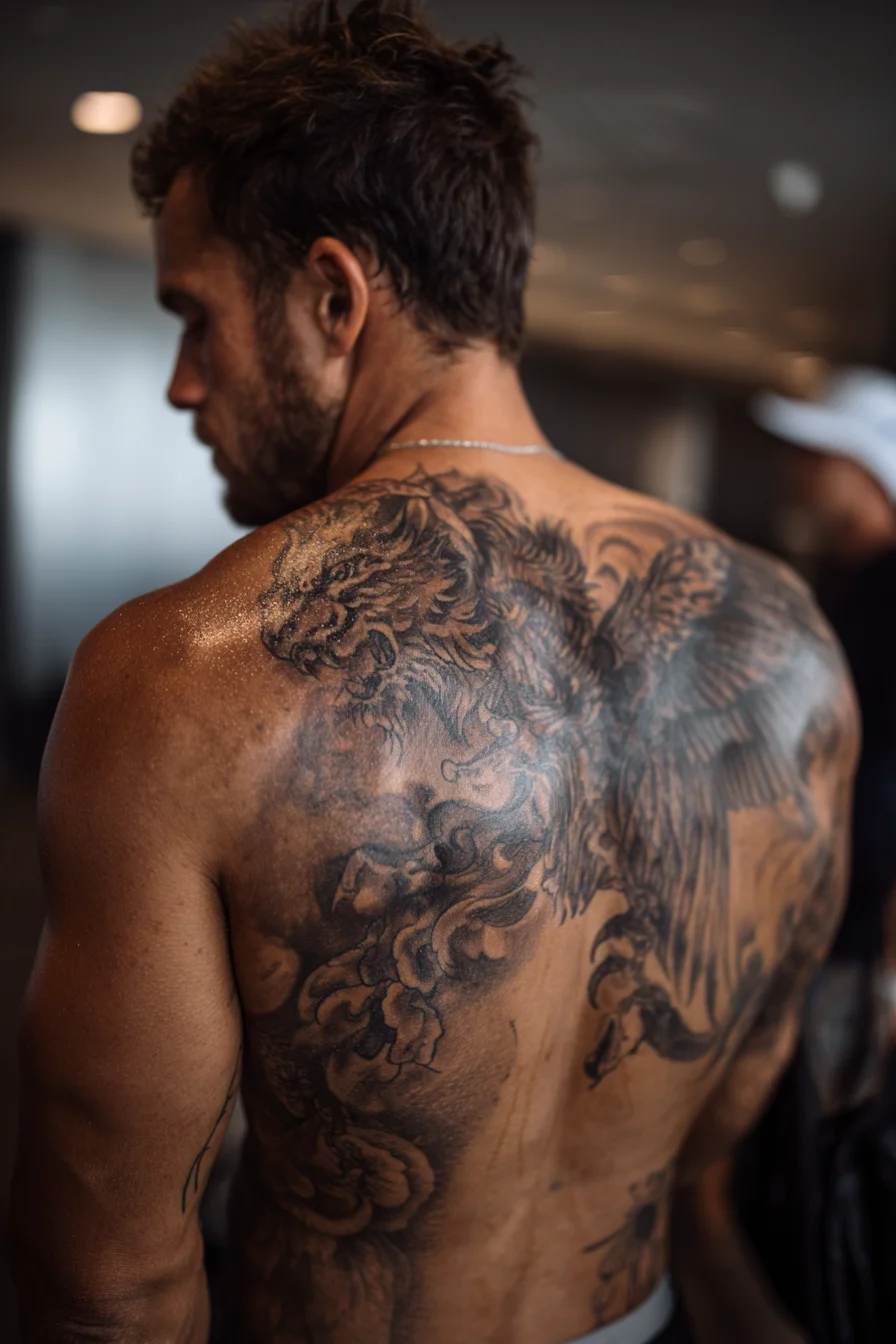
A winged lion or griffin back piece reads as a bold symbol of strength, protection and leadership. This black-and-grey design uses heavy linework and soft shading to accentuate shoulder breadth and wing span, giving motion and depth across the upper back. Placement suggestions: commit to a full upper-back or full-back canvas for maximum detail and visual impact; alternatively choose a shoulder-blade or upper-shoulder panel if you want a more concealable option that can later be expanded. Pain expectations: much of the fleshy upper back is moderate in pain, but expect sharper sensitivity over the scapula, spine and lower ribs — plan multiple 3–5 hour sessions to manage discomfort. Size considerations: preserve intricate feather and mane detail by working at true full-back scale (shoulder to mid-spine); smaller 6–10 inch reductions will lose micro texture and shading nuance. Styling variations: keep classic black-and-grey realism for a masculine look, add selective color accents (gold or crimson) for contrast, or integrate Japanese clouds/waves, geometric framing, or dotwork backgrounds to personalize the narrative. Practical tip: consult an experienced artist to align the piece with your musculature, allow 2–3 weeks initial healing, avoid sun and heavy sweating, and budget 10+ hours for completion.
Full-Back Raven & Mountain Landscape Tattoo — Blackwork Forest Realism
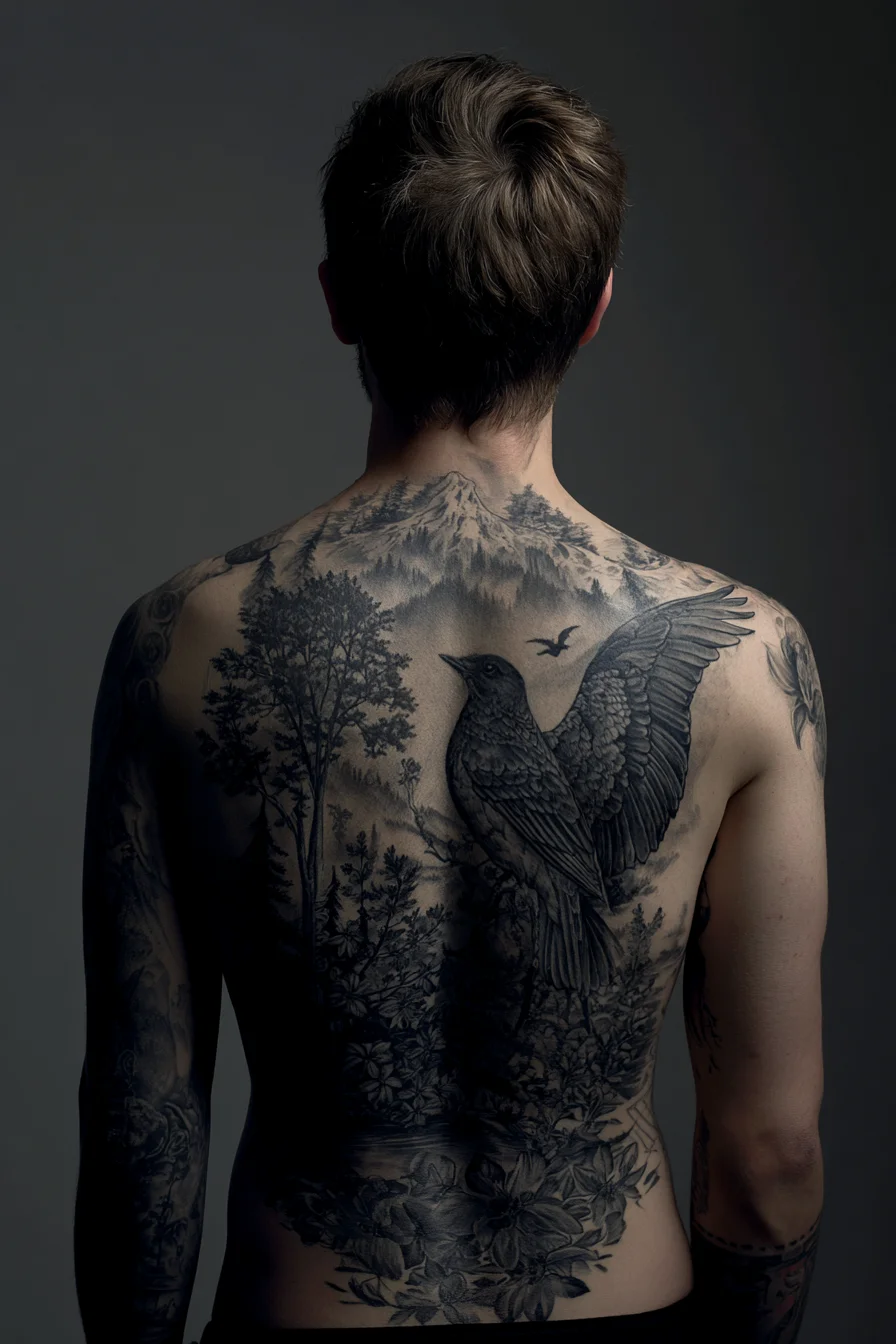
This expansive full-back design pairs a large raven with layered mountain and forest scenery — a visual statement of resilience, instinct and connection to nature. Executed in blackwork and fine grayscale shading, it balances bold silhouettes (the bird and peaks) with delicate texture (feathers, trees, and floral undergrowth) for a masculine, timeless aesthetic. Placement suggestions: ideal as a full-back piece spanning shoulder blade to lower back; it can be scaled down to a three-quarter back, centered along the spine, or extended into a shoulder/chest sleeve for continuity. Pain level expectations: overall moderate — the fleshy mid-back and lower lumbar tend to be more tolerable, while the spine, scapula edges and ribs produce sharper discomfort. Size considerations: to retain feather and foliage detail, allow a large canvas (minimum width ~10–12 inches); more surface area improves realism and legibility. Plan multiple sessions (several 3–6 hour sittings) and expect surface healing in ~2 weeks, with full settling over months. Styling variations: black-and-gray realism, dotwork textures, high-contrast blackwork, or subtle color washes (deep blues/greens) and negative-space highlights to personalize the piece. Consult your artist for composition that complements your anatomy and lifestyle.
Ornamental Mandala Full-Back Tattoo — Blackwork & Dotwork Spine Design
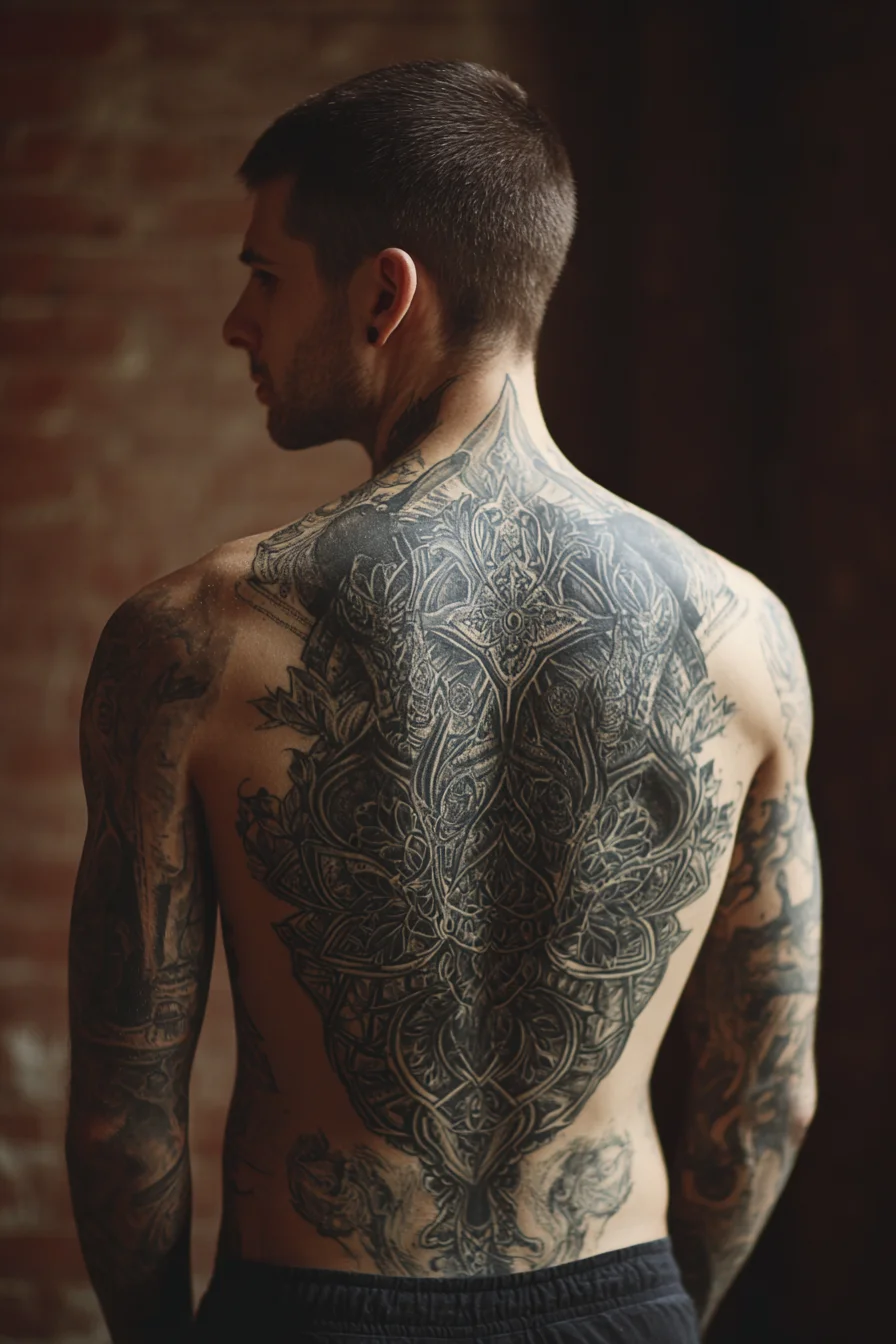
This bold ornamental mandala backpiece blends blackwork linework, filigree and dotwork into a symmetrical statement that reads as strength, balance and a mapped life journey. Mandala and ornamental motifs often symbolize inner balance, protection and personal evolution; the layered detailing gives the piece a crafted, resilient look that suits a masculine canvas. Placement suggestions: ideal as a full-back centerpiece, it also adapts to an upper-back/shoulder cap, a vertical spine column, or extension across the chest and into sleeves for a cohesive wraparound. Pain expectations: anticipate moderate discomfort overall — broad muscle areas (upper back and shoulder blades) are generally more tolerable, while the spinal column, shoulder blade edges and lower back/tailbone register higher sensitivity; expect sharper sensations near bony landmarks. Size considerations: preserve fine filigree by keeping the design large (full-back or generous upper-back) and plan multiple 3–5 hour sessions; scaling down will reduce clarity and detail. Styling variations: pure blackwork, high-contrast dotwork shading, selective deep-color highlights, or integration with geometric/tribal elements. Consult your artist about line weight, negative space and touch-up timing to ensure longevity.
Architectural Full-Back Tattoo with Floral Accents — Bold Male Backpiece
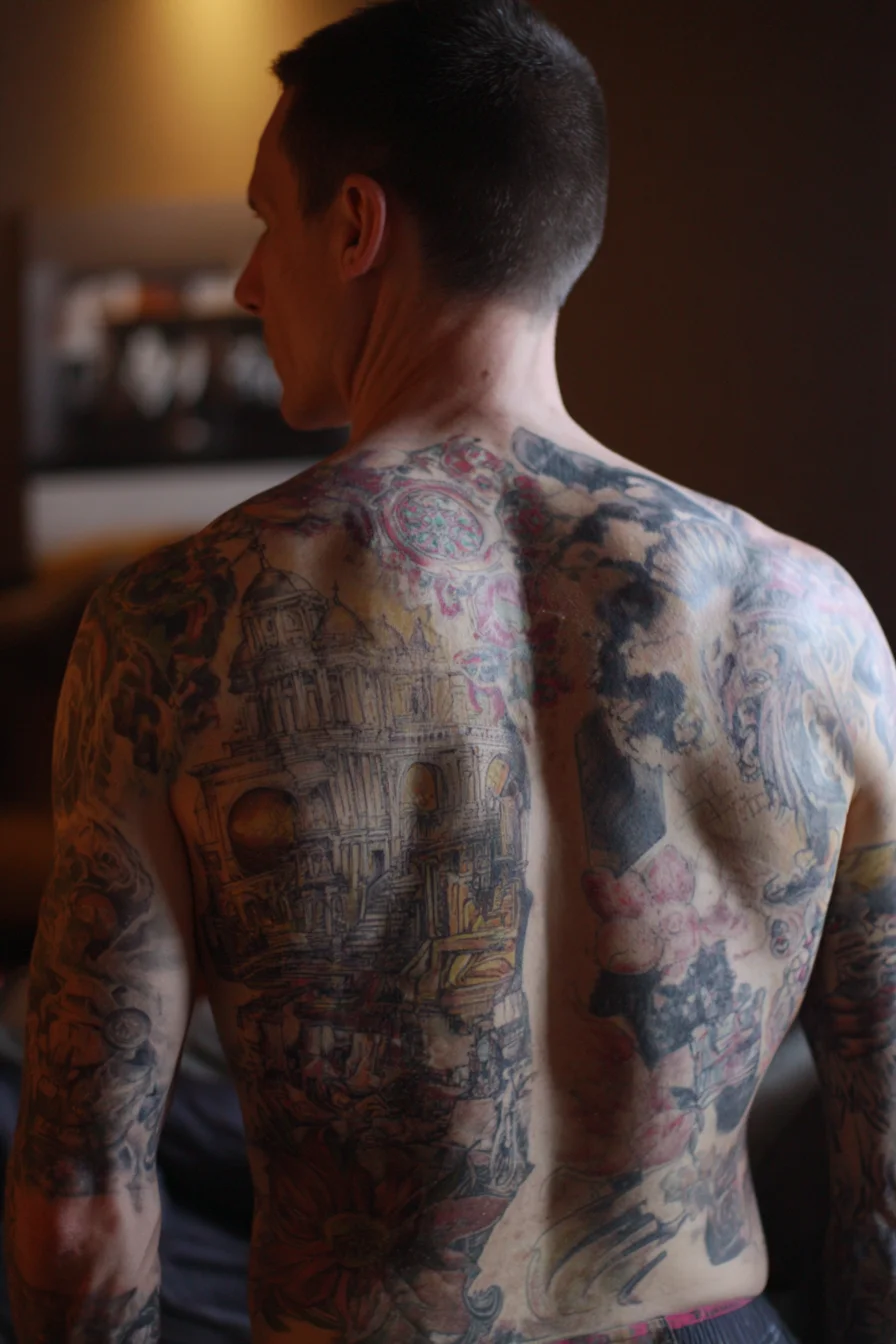
This full-back design blends detailed architectural imagery with floral accents to create a narrative of strength, legacy and contrast — the solidity of classical structures balanced by organic blooms. For men considering body art, the piece reads masculine without losing visual intricacy: architecture communicates permanence and resilience, while flowers add movement and color contrast. Placement suggestions: ideal as a full-back or upper-back centerpiece spanning the shoulder blades and tapering toward the lower back; it can be adapted into a one-sided back panel or expanded into a full torso or sleeve connection. Pain expectations: anticipate moderate discomfort across fleshy areas of the upper back and shoulders, with higher sensitivity and sharper pain along the spine, lower back/ribs and over the shoulder blades. Size considerations: fine architectural detail demands a large canvas — plan for a true full-back (20–30+ cm width) or large panels to preserve linework; smaller reductions will lose detail. Styling variations: black-and-grey realism for a classic look, selective color highlights in the floral elements, neo-traditional bold lines, or watercolor backgrounds for a softer contrast. Consult an experienced artist to map contours, session planning, and healing/aftercare for optimal results.
Full-Back Japanese Dragon Tattoo — Black & Gray Irezumi Style
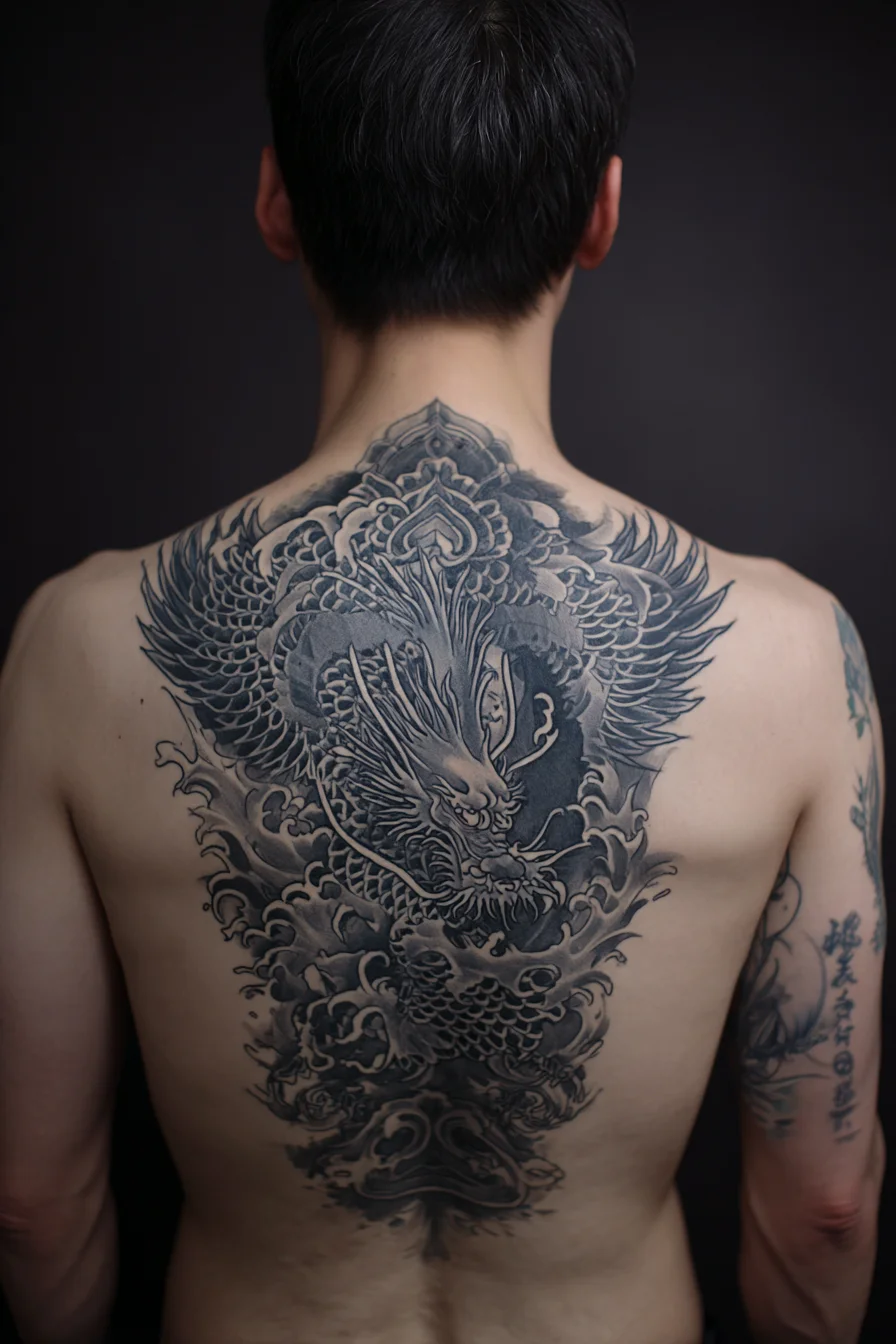
The dragon is a classic symbol of strength, protection and wisdom in East Asian tattooing; paired with waves and clouds it communicates movement, resilience, and control over chaos. This full-back composition centers the dragon along the spine to use natural contours for flow; ideal placements include the upper-to-mid back with extensions onto the shoulders, upper arms or lower back for a cape-like effect. Expect pain to range from mild in the fleshy outer back to moderate or higher along the spine, shoulder blades and near the ribs—plan multiple shorter sessions if you have lower pain tolerance. For clarity and longevity, this level of detail benefits from a large canvas (most artists recommend at least 30–40 cm vertical coverage) so scales, whiskers and waves read well from a distance. Styling options include pure black-and-gray realism, bold traditional irezumi with saturated color, illustrative dotwork, or high-contrast neo-traditional linework; negative-space highlights or white ink can enhance depth. Discuss flow with your artist, book staged sessions, and follow aftercare to preserve sharpness and tonal gradients.
Full-Back Japanese Dragon Tattoo — Black & Grey Dragon Back Piece
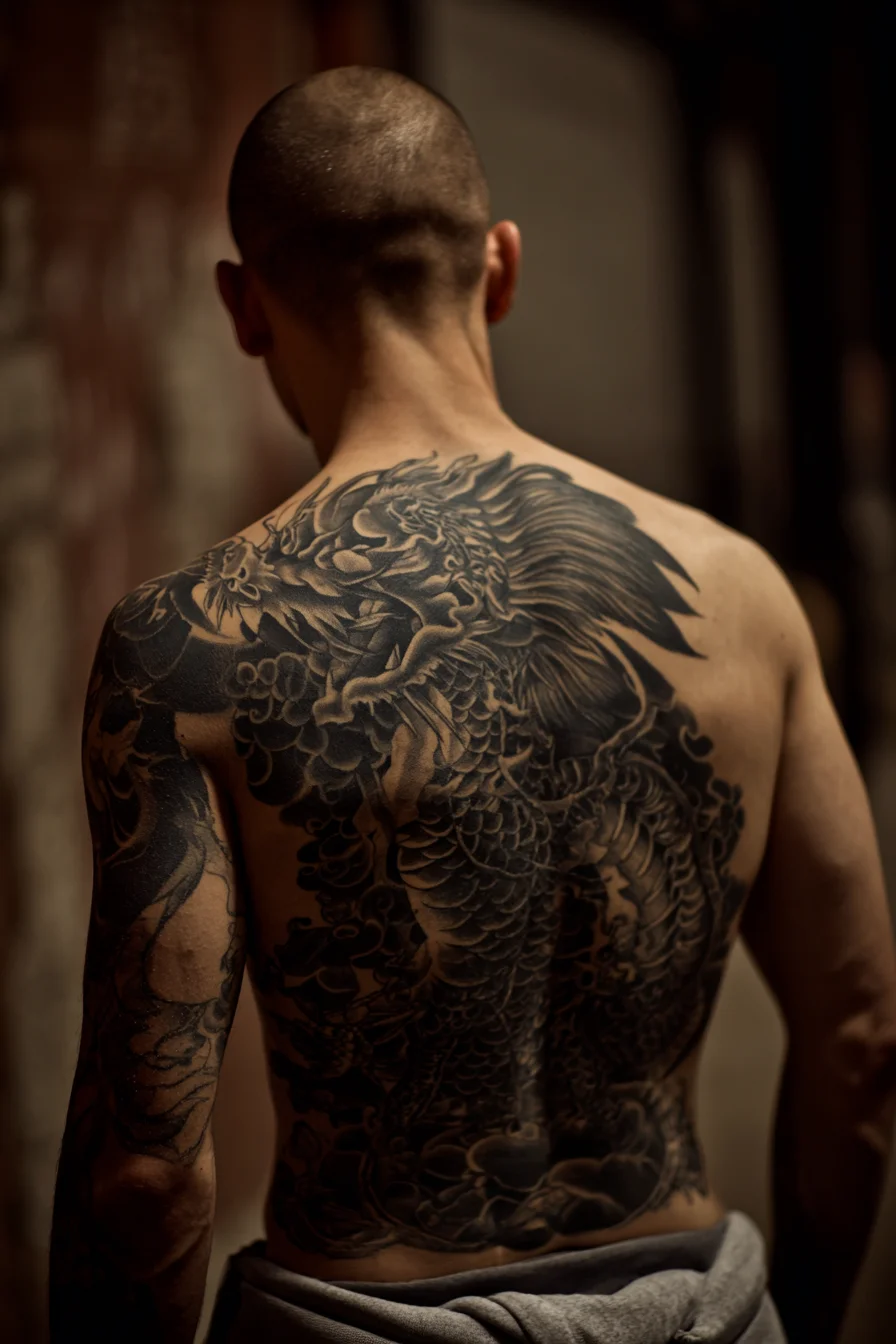
This dramatic full-back dragon is rooted in traditional Japanese irezumi: a sweeping dragon body, layered scales, wind-bars and cloud/wave fills convey strength, protection and transformation—qualities many men choose to express through body art. Placement-wise the full back is ideal to capture the design’s flow; it also works well as a shoulder-cap to sleeve extension or a wrap-around that meets a chest or rib piece. Expect varied pain: broad muscle areas of the upper back and shoulders are moderately tolerable, while work directly over the spine, shoulder blades’ edges and lower ribs tends to be more intense. Size considerations are practical—full-back coverage typically requires multiple sessions totaling 8–20+ hours depending on detail and shading; plan consultations to break work into 3–6 sessions. Styling variations include full black-and-grey realism, bold traditional irezumi color (red, indigo, gold accents), dotwork backgrounds, or integrating peonies, chrysanthemums, or a koi-to-dragon transition. Discuss line weight and negative-space placement with your artist to ensure the composition complements your musculature and ages well; budget touch-ups after healing for optimal longevity.
Heraldic Lion Crest with Wings — Full Upper Back Tattoo
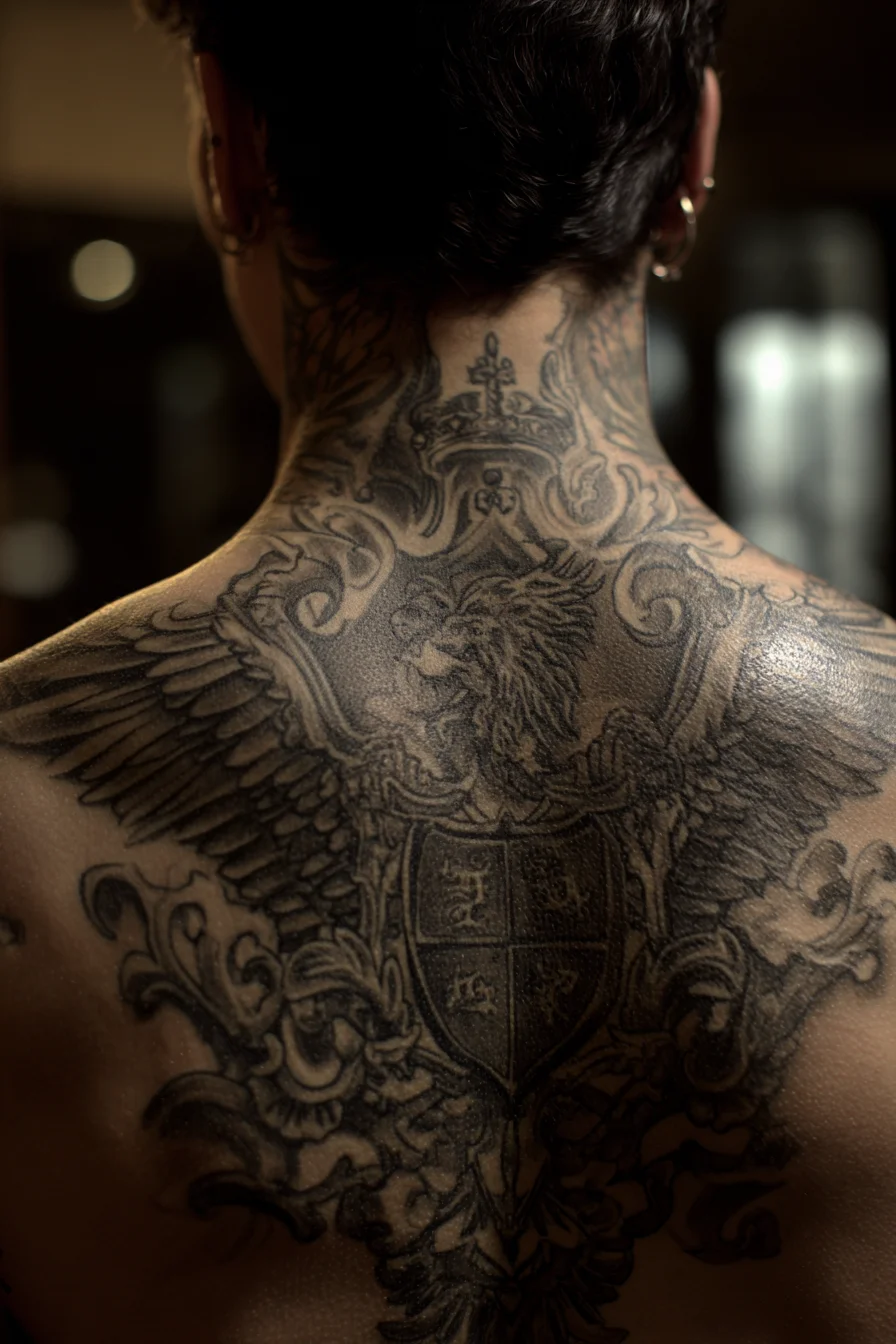
This detailed heraldic lion crest with outstretched wings reads as strength, protection and noble authority — a bold, masculine choice for men who want a statement back piece. The lion symbolizes courage and leadership, the crown adds authority, the shield denotes protection or family lineage, and the wings introduce freedom and movement. Placement suggestions: ideal for the full upper back and shoulder span to preserve scale and symmetry; extendable up the nape or down the spine, or split across the chest and shoulders for a chest-plate effect. Pain expectations: upper back and deltoids are typically moderate in discomfort; areas over the spine, shoulder blades and nape are more sensitive and may require shorter sessions. Size considerations: this design benefits from a large canvas — at least shoulder-to-shoulder width — so fine heraldic detail and shading read clearly; small versions will lose definition. Styling variations: black-and-grey realism or high-contrast dotwork for a classic look, neo-traditional with selective color (gold/carmine) for emphasis, or simplified line-work for chest/arm adaptations. Discuss session length, healing timeline and touch-up planning with an experienced artist to preserve detail over time.
Full-Back Japanese Dragon Tattoo — Black & Grey Dragon Design
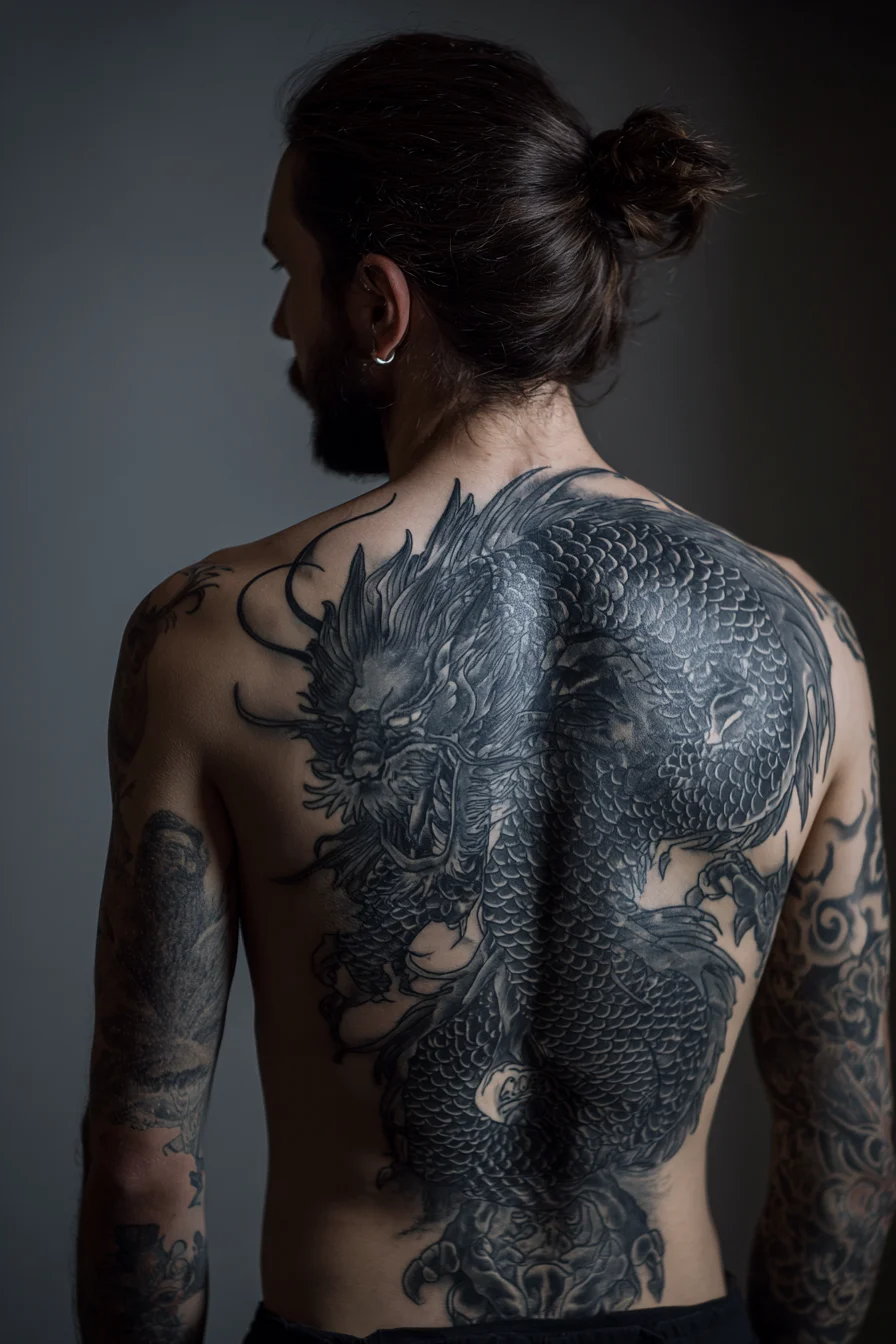
This full-back Japanese dragon conveys classic meanings: strength, protection, wisdom and the perseverance to overcome obstacles. The sinuous composition and dense scale work read well on a broad canvas, making it an ideal statement piece for men seeking a bold, symbolic tattoo. Placement: designed to cover the entire back, it can wrap over the shoulders, down onto the ribs or connect to a sleeve. For a subtler option consider a half-back or shoulder-to-chest placement. Pain: expect variable discomfort — outer shoulder blades and fleshy lower back are moderate, while areas over the spine, ribs and near the tailbone are more painful. Break the work into multiple sessions to manage endurance and healing. Size and process: a true full-back dragon requires large scale to preserve scale detail and facial features; plan for several multi-hour sessions and touch-ups. Styling variations: keep it black & grey for a classic irezumi look, add selective color highlights (red or gold), or pair with background elements like clouds, waves, peonies or koi. Choose an artist experienced in traditional Japanese linework and shading. Aftercare: sun protection and periodic touch-ups maintain contrast and edge crispness.
Full-Back Phoenix Tattoo — Black & Grey Avian Back Piece for Men
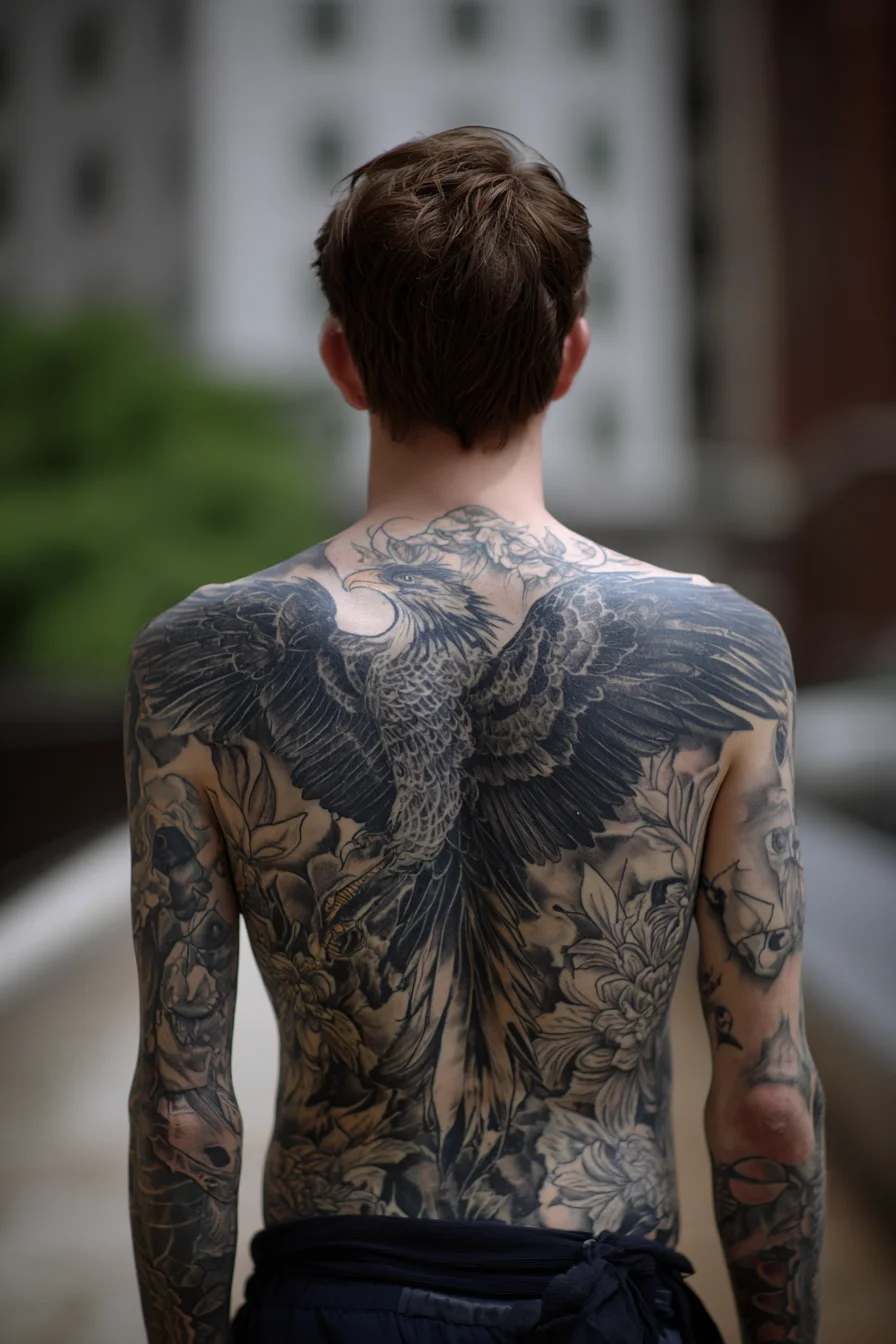
This dramatic full-back design centers on a large avian figure—interpreted as a phoenix or eagle—wings spread across the shoulder blades with detailed feather work and surrounding floral elements. Meaningfully, it reads as a symbol of strength, resilience, and personal rebirth, while the flowers add balance and an element of natural beauty. Placement suggestions: the full back is ideal to preserve scale and detail; consider upper-back-only for a shorter session plan, or extend the wings onto the shoulders and upper arms for a connected chest or sleeve piece. Pain expectations: the fleshy areas of the upper back are moderate in pain, but expect sharper discomfort over the spine, shoulder blades, and near the ribs; sessions of 2–6 hours are common. Size considerations: maintain a large canvas (full or three-quarter back) to keep feather texture and floral shading legible; reducing size will require simplifying linework. Styling variations: stick with black-and-grey realism for a classic, masculine look, or add selective color (red/orange highlights for a phoenix) for contrast; alternatively, adapt to neo-traditional, dotwork, or Japanese motifs for a cultural twist. Discuss session planning, aftercare, and sketch revisions with your artist to match proportions to your physique.
Upper-Back Mandala & Guardian Mask — Bold Blackwork Tattoo for Men
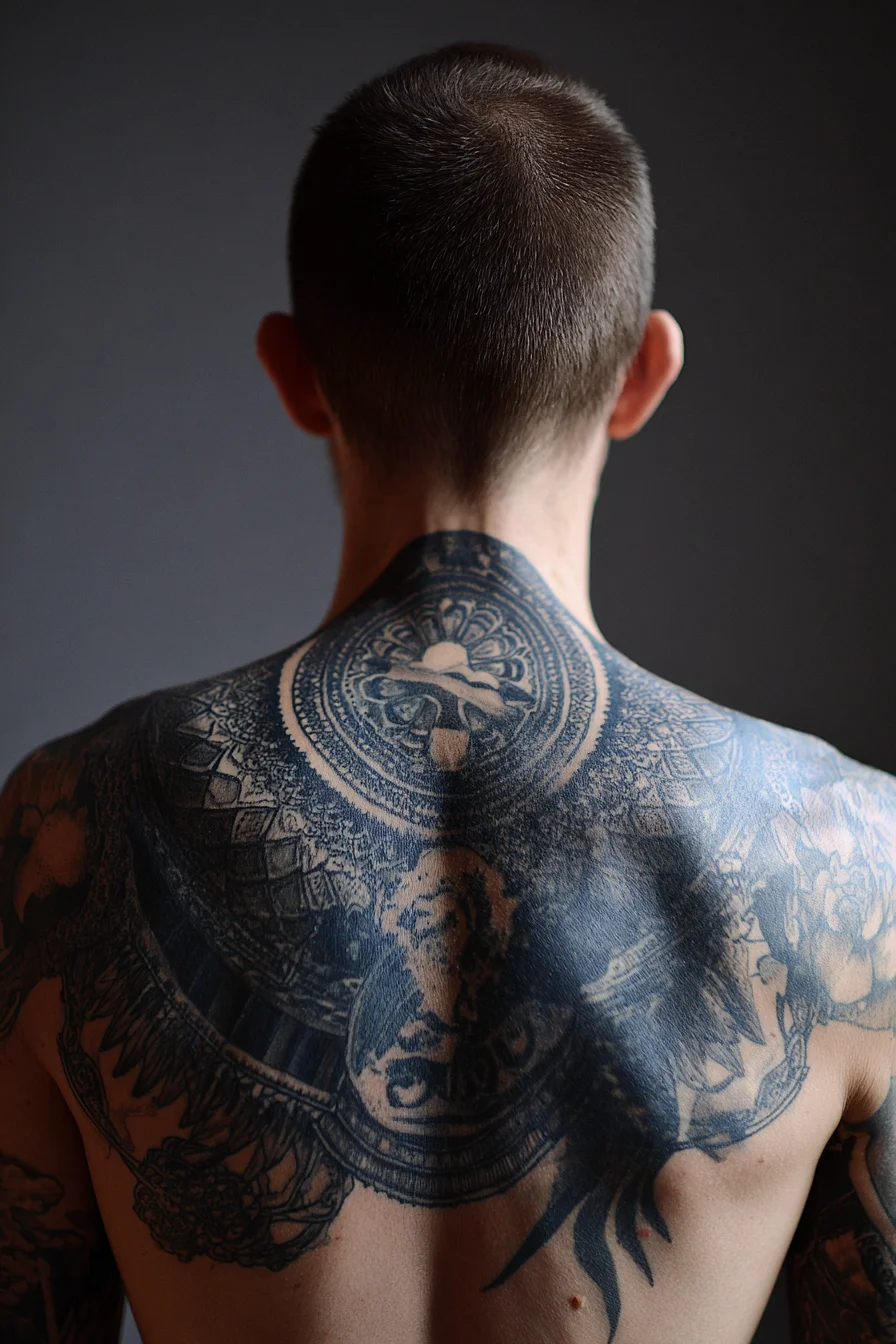
This bold ornamental blackwork design pairs a large mandala-inspired circle at the nape with a stylized guardian face and heavy tonal shading across the upper back. The composition reads as a symbol of balance, protection and personal strength—the mandala brings symmetry while the mask or guardian element suggests resilience and watchfulness. For placement, this works best as an upper-back centerpiece that can extend across the shoulders or down the spine; it also adapts well to a full-back project or a nape-to-shoulder wrap. Expect moderate pain overall: fleshy upper-back areas are generally tolerable, while the nape, spine, and edges over shoulder blades will feel sharper and may require shorter sessions. Size considerations: maintain a large format to preserve the intricate linework and dot shading—pieces under 6–8 inches often lose detail. Plan multiple sessions for layering and contrast. Styling variations include adding selective color highlights (reds or golds), increasing dotwork texture, converting the guardian face to a more realistic portrait, or integrating tribal/neo-traditional elements to match sleeve work and create a cohesive masculine look.
Symmetrical Ornamental Back Tattoo — Spine-to-Shoulder Blackwork
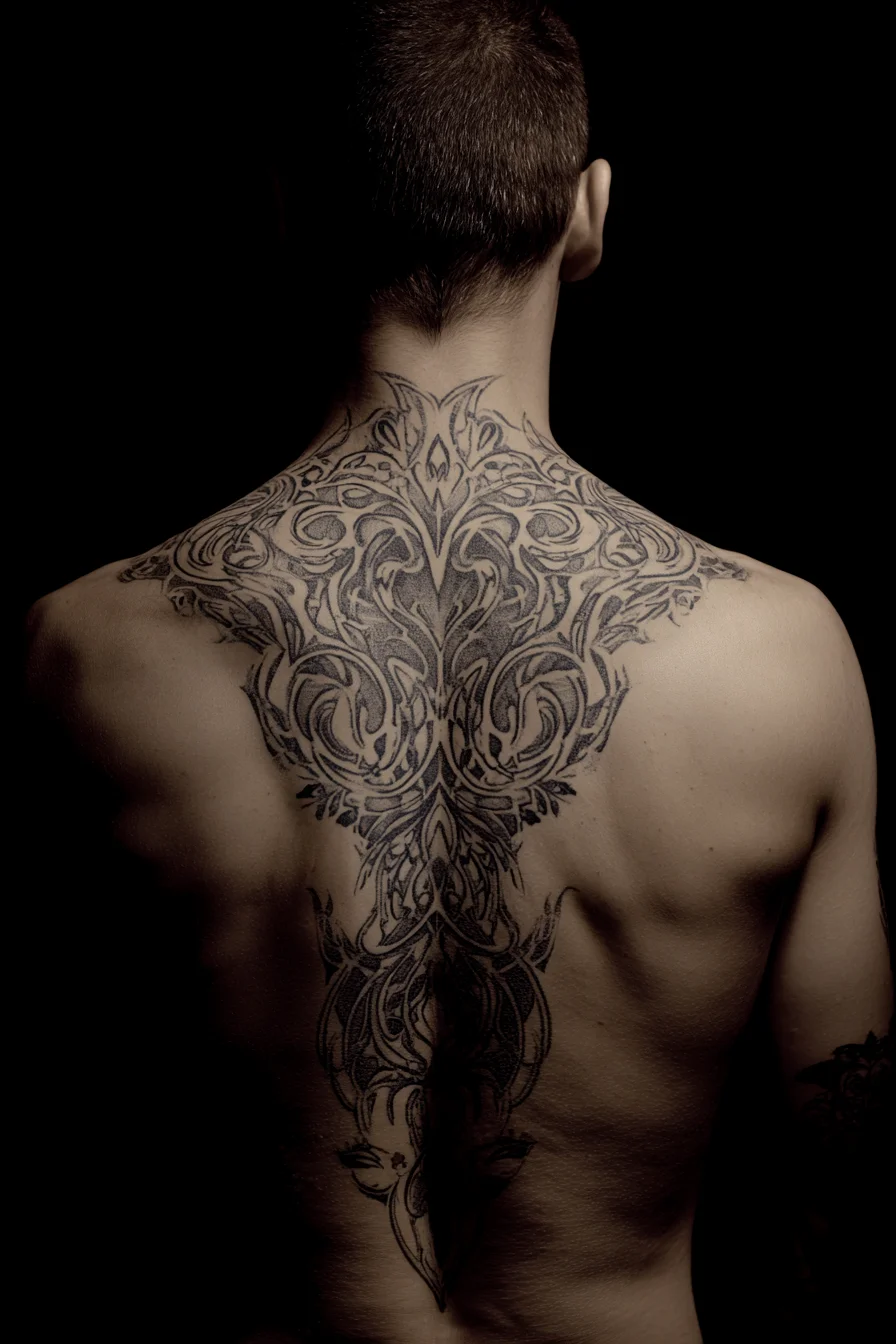
This bold, symmetrical ornamental design reads as a statement backpiece: flowing blackwork patterns mirror down the spine and across the shoulders for a strong, masculine silhouette. Conceptually it suggests balance, protection and personal mythology — an ideal choice for men seeking a central, cohesive motif rather than scattered pieces. Placement suggestions: best suited to the upper- to mid-back, spanning the nape and shoulder blades and tapering down the spine; it can also be scaled up to a full-back or shortened to sit only between the scapulae. Pain expectations: shoulder and upper-back areas are generally moderate in discomfort; the midline over the spine and near the vertebrae will be more sensitive and may require shorter sessions. Size considerations: to preserve the intricate negative-space details, keep the design medium-to-large (at least 8–12 inches across for full clarity); very small renditions lose definition. Styling variations: bold tribal blackwork for high contrast, dotwork or smooth shading for texture, subtle color accents for depth, or integration with sleeves/neckpieces. Consult an experienced artist to adapt line weight to your anatomy and schedule multiple sessions for optimal healing and detail retention.
Ornamental Black & Grey Floral Backpiece Tattoo — Upper Back and Spine
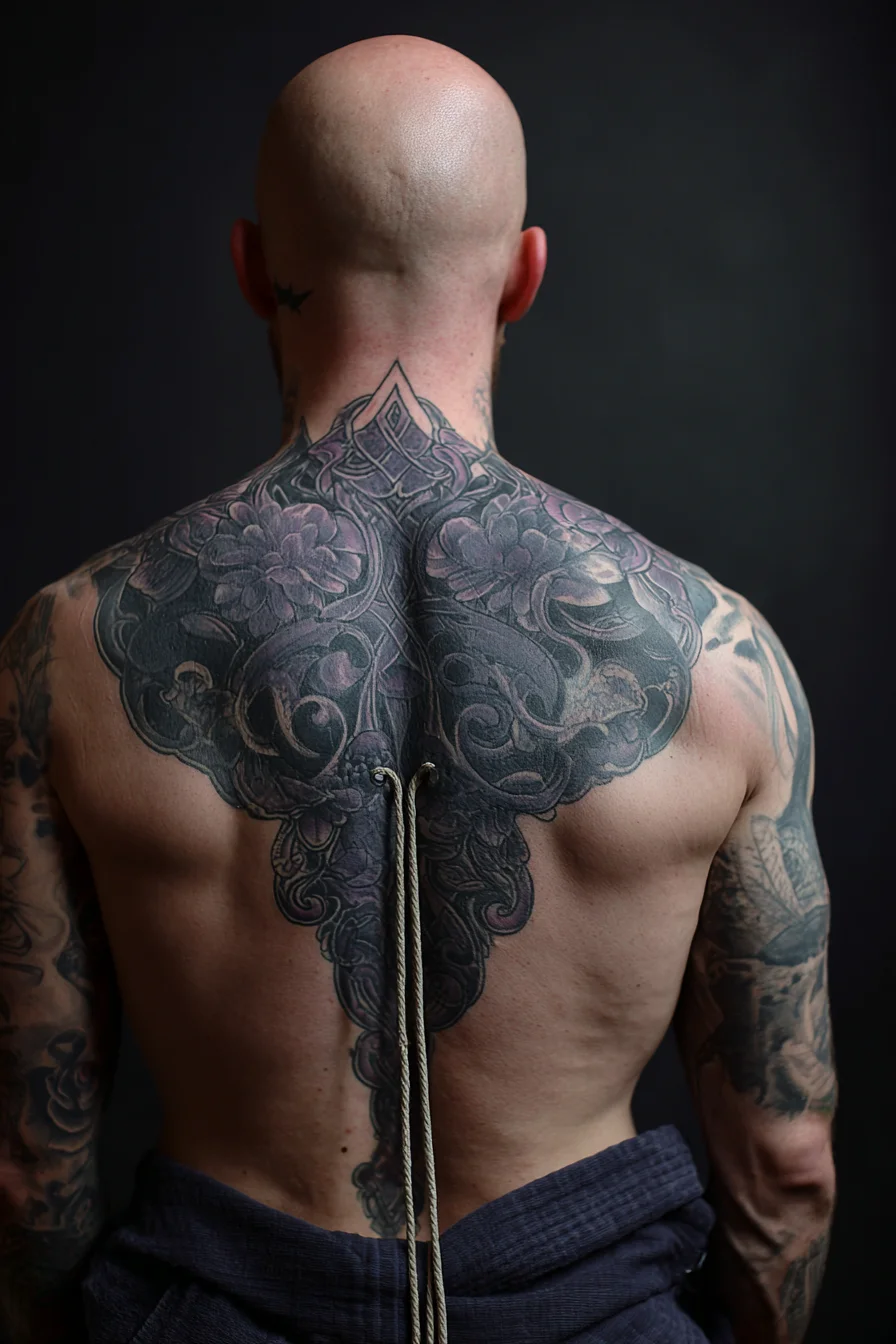
This ornamental black-and-grey floral backpiece reads as a statement of resilience and balance: layered petals and filigree form a symmetrical mandala that follows the natural lines of the shoulder blades and spine. Meaningfully, floral motifs convey growth and renewal while the ornamental framing adds structure and permanence. Placement suggestions: center the piece across the upper back with the focal point between the shoulder blades, allowing an optional vertical extension down the spine or a subtle neck extension. Pain level expectations: overall moderate — broad muscle areas across the shoulders are tolerable, while work directly over the spine and cervical vertebrae can be significantly more sensitive. Size considerations: this design performs best at a large scale to retain intricate linework and shading; consider a full upper-back layout or staged sessions to build the piece. Miniaturizing will sacrifice detail. Styling variations: pure black-and-grey realism, heavy dotwork/linework contrast, or a muted color wash (deep purples or indigo) for highlights. It also adapts well into chest pieces or full sleeves for a cohesive body-art plan. Follow professional aftercare and expect 2–3 weeks for surface healing.
Blackwork Phoenix Back Tattoo — Large Shoulder-Blade Spread
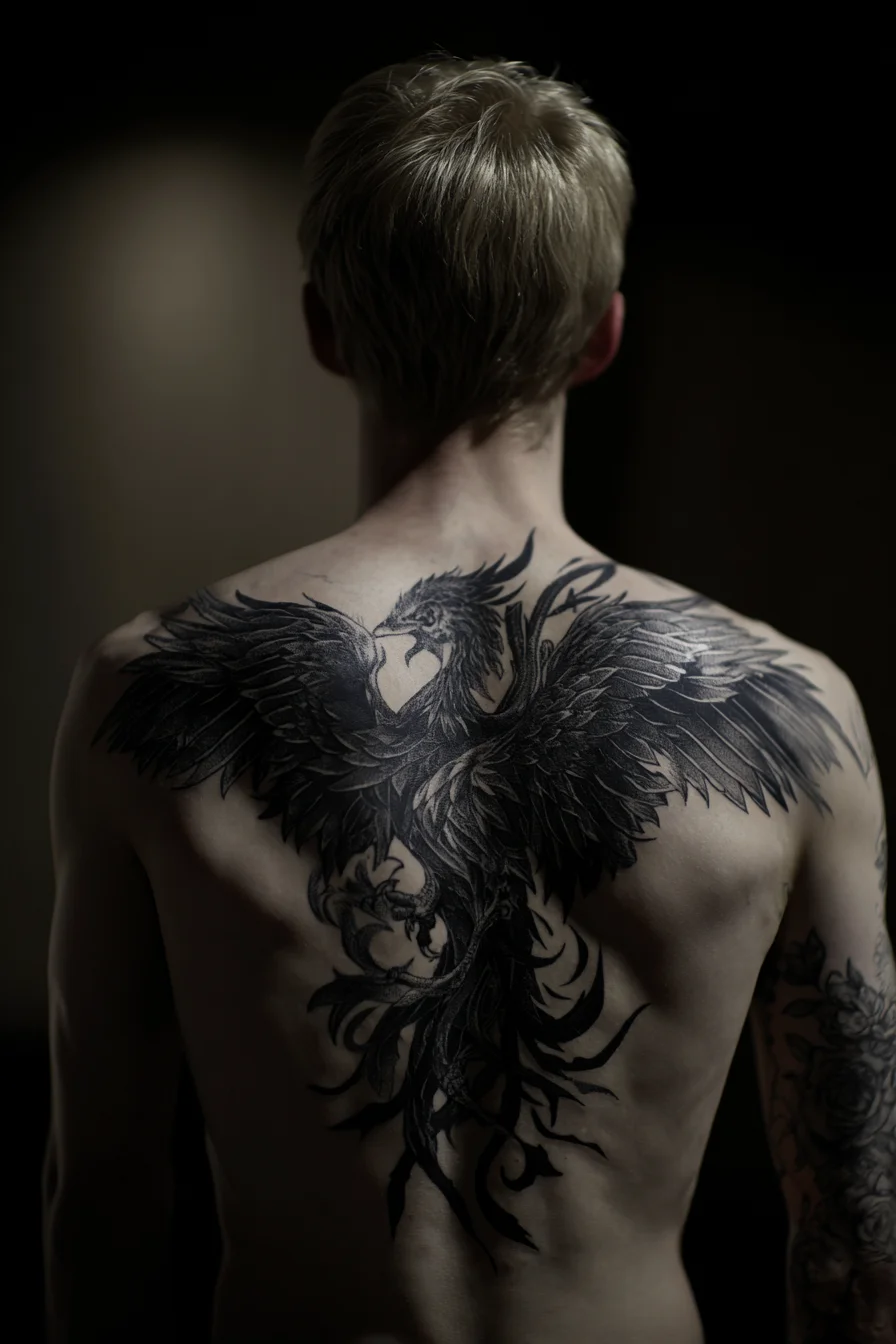
This bold blackwork phoenix spans the upper back with wings outstretched across the shoulder blades and an ornate, flowing tail down the spine. Symbolically, the phoenix represents rebirth, resilience, and personal transformation — themes that resonate strongly for men seeking a statement piece. Placement suggestions: the upper-back/shoulder-blade canvas suits this design best for balance and symmetry; consider a full-back expansion if you want the tail and feathers to flow lower toward the lumbar region or wrap onto the arms. Pain expectations: expect low-to-moderate discomfort across fleshy areas of the shoulders, with sharper sensitivity along the spine, shoulder blades, and near the ribs if extended. Size considerations: to preserve detail, this motif benefits from medium-to-large scale (at least 8–12 inches across); intricate featherwork and shading require ample surface area and multiple sessions. Styling variations: pure blackwork or dotwork for a masculine, graphic look; realistic shading for depth; or selective color (flame accents in red/orange) to emphasize the phoenix theme. Discuss session planning and aftercare with your artist to match line weight, contrast, and long-term visibility.
Full-Back Winged Oni Demon Tattoo — Black & Grey Back Piece for Men
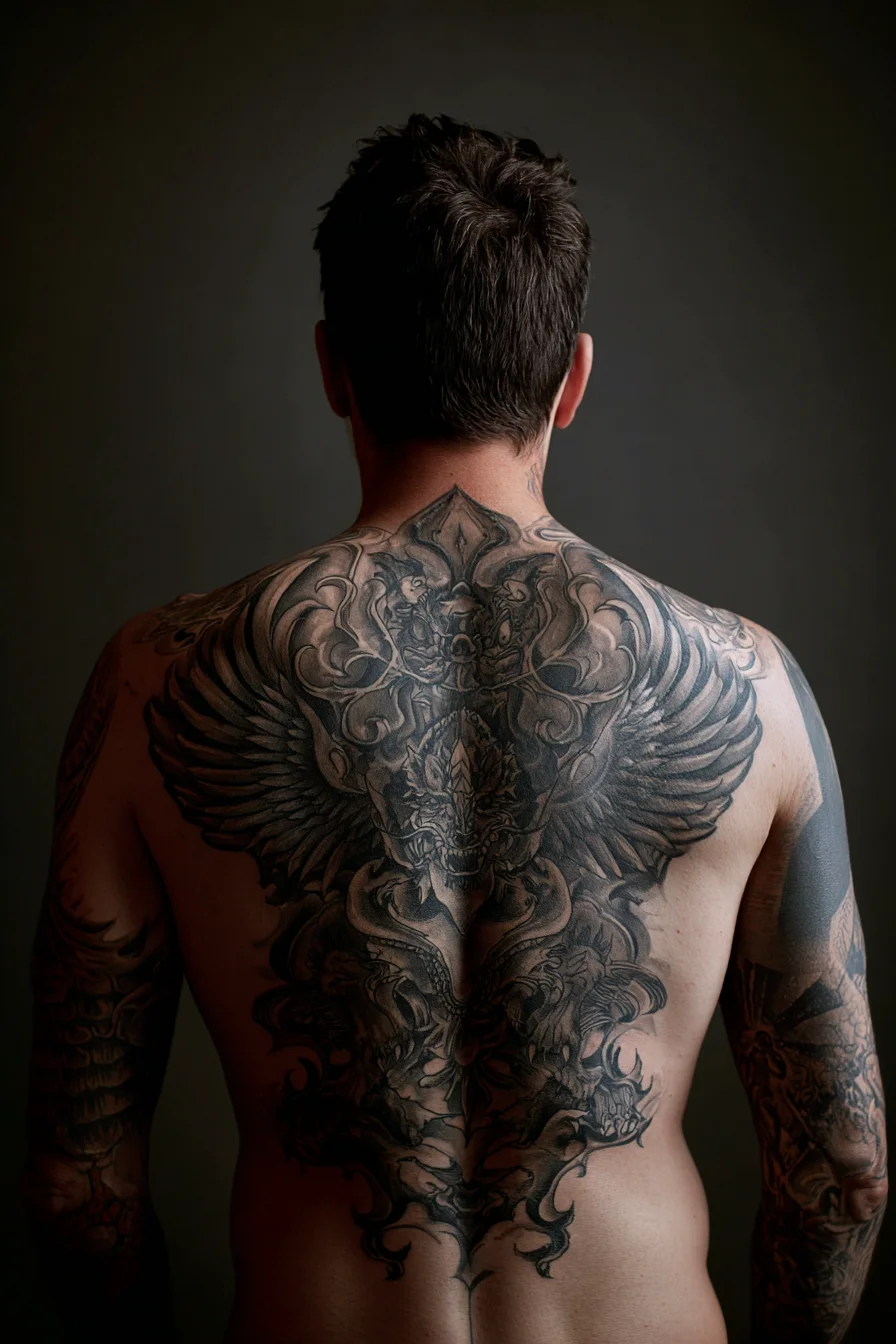
This dramatic full-back winged oni/demon piece pairs a fierce mask with expansive feathered wings and ornamental filigree, communicating strength, protection, and the tension between darkness and redemption. Placement is best centered on the back, spanning the shoulder blades and flowing down the spine; it also integrates seamlessly into full sleeves or a chest piece if you want a cohesive torso composition. Pain expectations vary: the fleshy outer back and shoulders are moderate, while areas over the spine, shoulder blades and lower ribs are notably more sensitive — plan multiple shorter sessions. Size considerations favor a large canvas to preserve fine shading, facial detail and layered wings; discuss scale with your artist to match your body proportions and future expansion. Styling variations include black-and-grey realism for depth and longevity, traditional Japanese (Irezumi) linework for bold outlines, selective color highlights (red/gold) for focal accents, or negative-space and dotwork backgrounds to lighten saturation and speed healing. Consult a trained, culturally-aware artist to adapt motifs, map sessions, and confirm aftercare for optimal long-term results.
Full-Back Japanese Guardian Dragon/Oni Tattoo — Black & Grey Irezumi Style
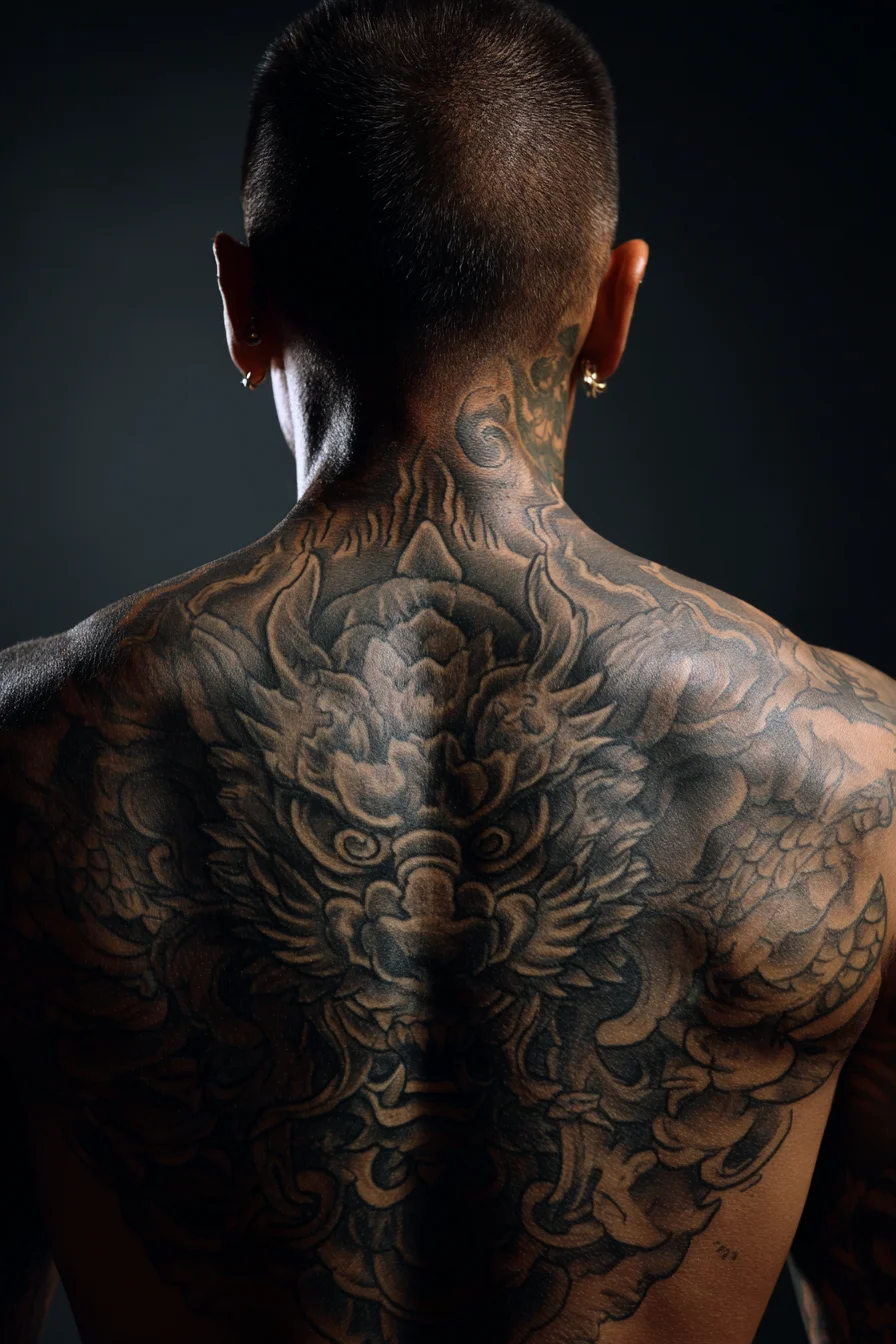
This dramatic full-back piece channels classic Japanese Irezumi themes — a guardian creature combining dragon and oni elements to convey protection, raw strength, and controlled ferocity. For men seeking a bold statement, the centered composition reads well from a distance while offering rich surfaces for shading and texture up close. Placement suggestions: full back is ideal to preserve scale and detail; a scaled-down upper-back, shoulder cap, or chest extension works if you prefer less coverage. Pain expectations: the upper back and shoulder blades are moderate in discomfort for most clients; expect sharper sensitivity along the spine, neck base, and near the shoulder joints. Size considerations: to retain the facial detail and layered scales you’ll need large canvases — half to full back —; shrinking the design will require simplifying linework and losing fine shading. Styling variations: stick with black-and-grey for a traditional, masculine look, or add restrained color accents (red, gold) for contrast; alternative treatments include bolder neo-traditional lines, dotwork background fills, or integrating the motif into sleeve and chest extensions. Plan multiple sessions, and budget touch-ups over time to keep contrast strong.
Black & Grey Rose Backpiece Tattoo — Realistic Floral Full-Back Design
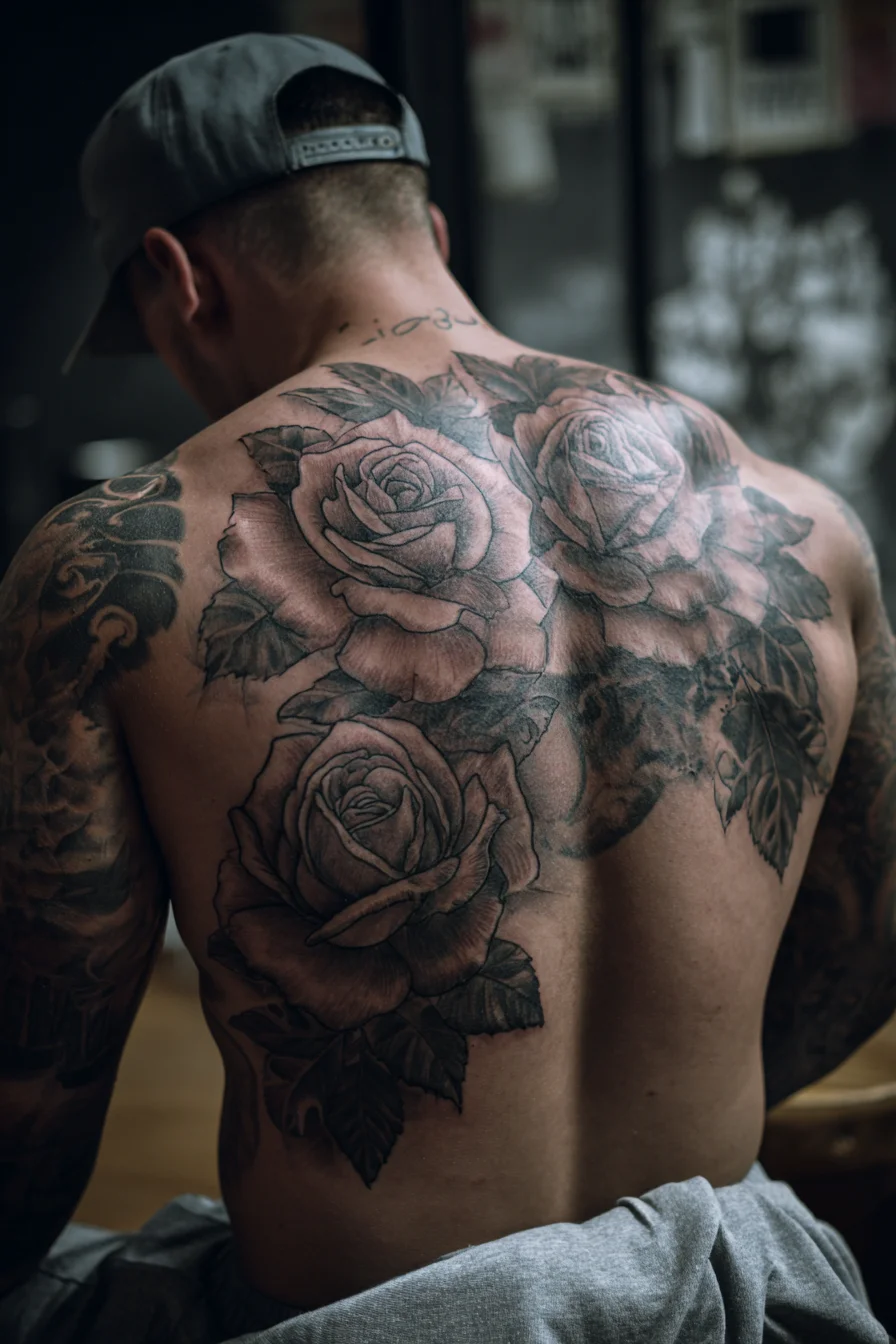
This black-and-grey rose backpiece reads as a classic, masculine floral statement—roses often symbolize love, loss, resilience and the balance between beauty and pain. Rendered in realistic shading, the composition works well as a standalone upper- or full-back piece and as an anchor for future sleeves or chest expansions. Placement suggestions: full back for maximum impact, upper-back/shoulder-blade spread for visibility under shirts, or a staggered layout wrapping toward the ribs or chest if you want asymmetry. Pain expectations vary by location: fleshy areas of the lower and mid-back are typically low–moderate, while the spine and shoulder blades are more sensitive and can feel intense during long sessions. Expect multiple sessions of 3–6 hours depending on tolerance. Size considerations: for realistic petals and deep shading, each rose should generally be at least a few inches across; a full-back layout requires a large canvas to preserve detail and contrast. Styling variations to consider: heavier blackwork and bold line accents for a more masculine look, added white highlights for pop, subtle color touches (deep red) for contrast, or geometric/mandala backgrounds for a contemporary twist.
Ornamental Symmetrical Back Tattoo — Blackwork Filigree Design
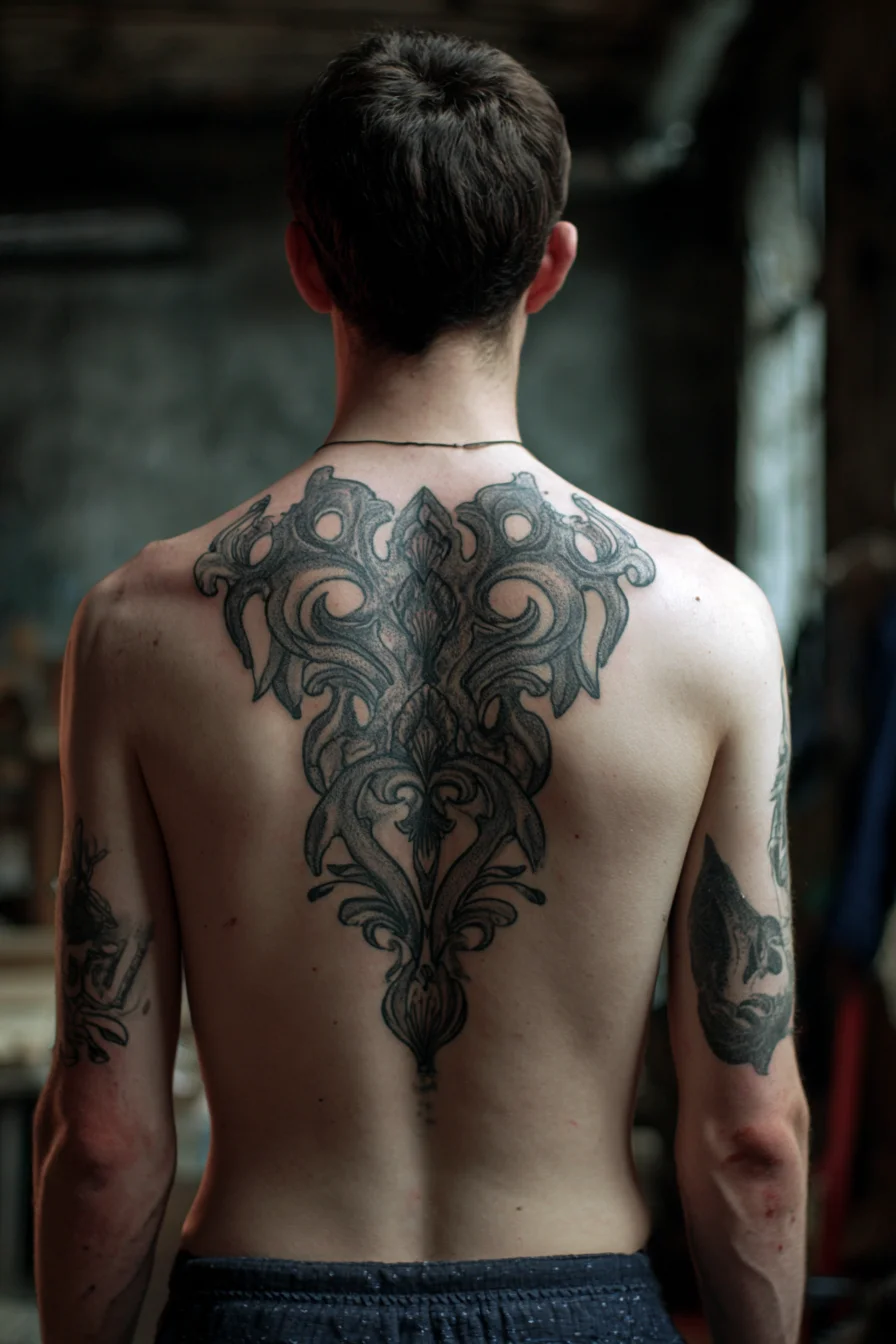
This ornamental, symmetrical backpiece reads as strength and balance: flowing filigree and mirrored forms draw attention to the spine and upper back, communicating discipline and personal symbolism without literal imagery. For men considering this style, common placements are centered between the shoulder blades and extending down the midline; it can remain an upper-back piece or be scaled to a full-back composition that wraps toward the shoulders. Expect a moderate pain level overall — broad muscle areas of the back are relatively tolerant, while work directly over the spine, shoulder blades, or near ribs will feel sharper and may require shorter, multiple sessions. Size matters: larger canvases preserve fine ornamental detail and age better, while small renditions risk line blurring; plan for multi-session work if you want dense shading or heavy blackwork. Styling variations include pure blackwork, greywash shading, dotwork textures, or selective color highlights; you can also integrate geometric panels, tribal motifs, or sleeve connections to match existing ink. Discuss scale, flow with musculature, and healing expectations with your artist to get a custom result that fits your body and lifestyle.
Ornamental Spine Back Tattoo — Blackwork Symmetrical Nordic-inspired Design
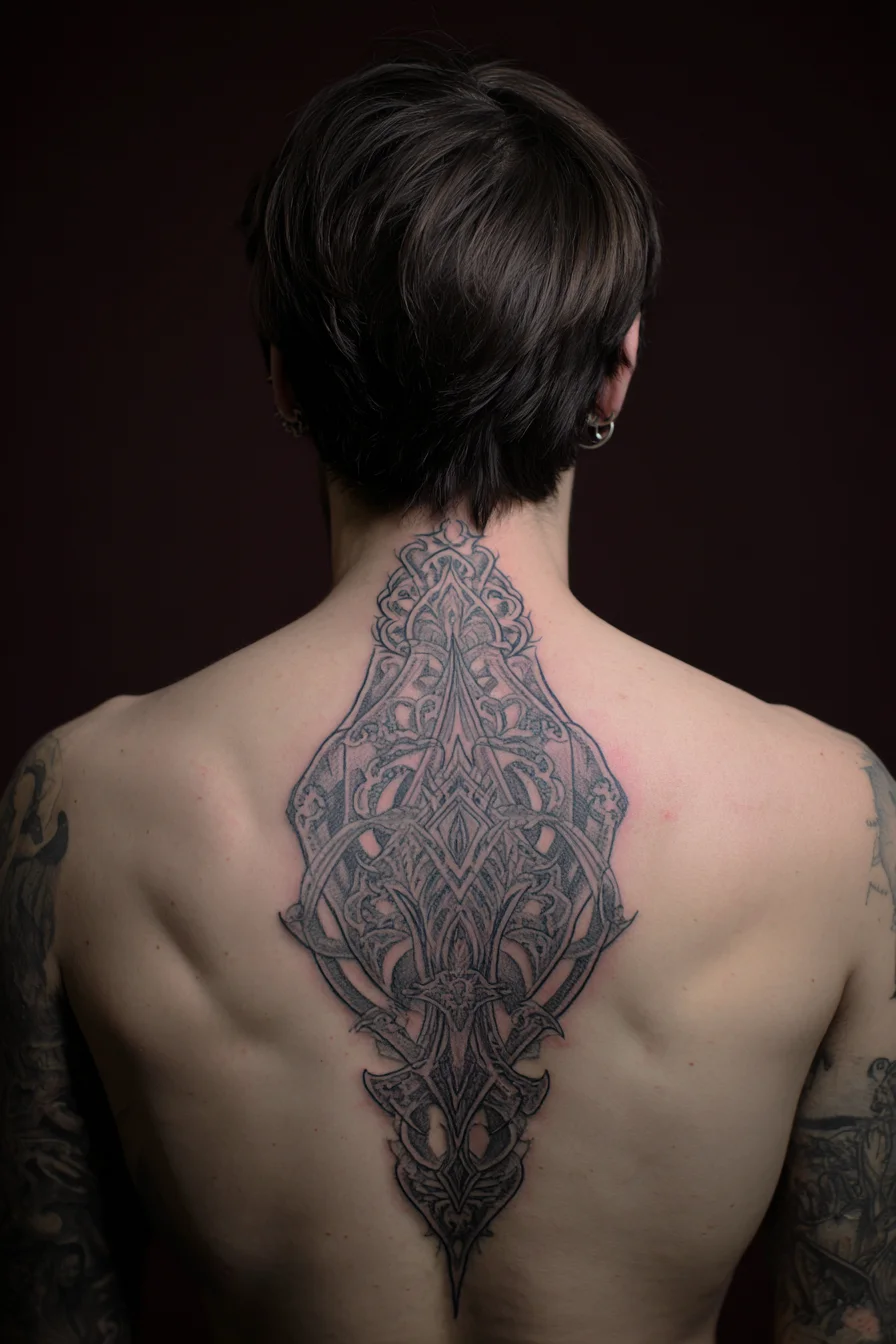
This elongated ornamental spine tattoo uses fine blackwork, interlaced filigree and symmetrical knot-like motifs to create a bold, masculine statement of balance, protection and personal lineage. The vertical composition emphasizes the spine’s natural axis, giving a strong central focal point that reads well from a distance while revealing detail up close. Placement suggestions: center the piece along the thoracic spine between the shoulder blades for a striking upper-back piece, or extend it upward toward the nape or downward toward the lumbar region for a full-spine look. Pain expectations: anticipate moderate to high sensitivity directly over vertebrae and near the neck; the fleshier areas around the scapula are less painful. Many clients break the work into multiple sessions for comfort. Size considerations: medium-to-large scale preserves the intricate linework—roughly a 6–14 inch vertical span depending on torso size; smaller versions risk losing detail. Styling variations: opt for heavier blackwork for a bold effect, add dotwork shading or subtle color accents for depth, introduce white highlights, or integrate the design into shoulder sleeves, chest pieces or Norse/Celtic knotwork for cohesive coverage. Discuss line weight and negative space with your artist to ensure longevity and readability.
Full-Back Fire Dragon Tattoo — Realistic Green Dragon with Flames
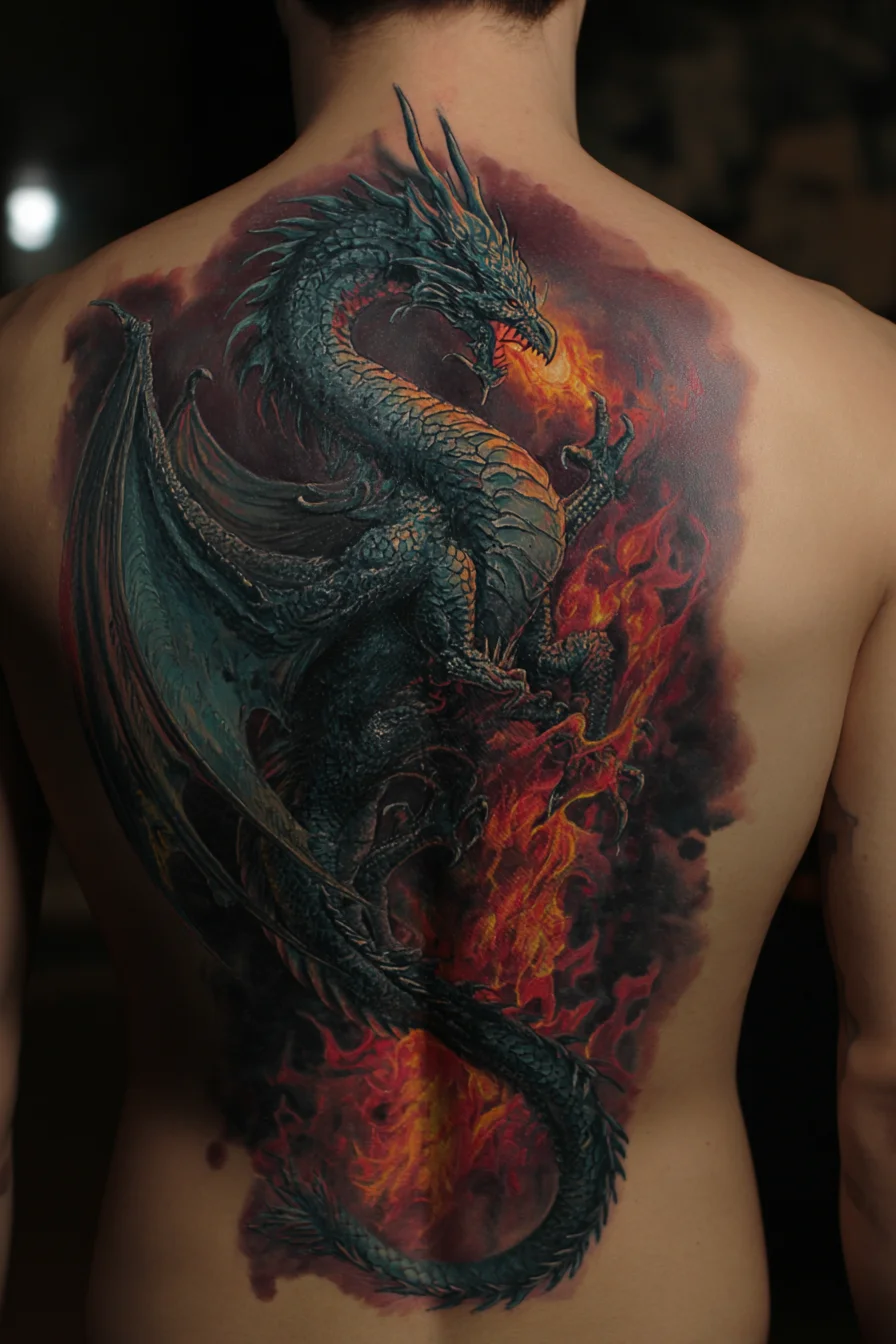
This dramatic full-back dragon combines mythic symbolism (strength, protection, rebirth) with a bold fire motif for a masculine, statement-making piece. The detailed scales and flame work read best at a large scale, so the design suits the full back or a large left/right back panel that wraps to the ribs or shoulder. Expect pain to range from moderate to high: fleshy areas of the upper outer back are more comfortable, while the spine, shoulder blade edges and near the ribs are the most sensitive. For optimal detail, plan for a large tattoo (roughly 30–40 cm / 12–16 in tall) executed over multiple sessions—outlining first, then layered shading and color saturation. Men wanting variations can opt for hyper-realistic color, muted black-and-gray for a darker tone, neo-traditional with bolder lines and stylized flames, or a Japanese irezumi interpretation with wind-bars and clouds. Discuss session length, placement to work with muscle lines, and a realistic budget and timeline with your artist. Expect initial healing of 2–4 weeks, potential touch-ups for color vibrancy, and aftercare guidance to protect the piece long term.
Symmetrical Ornamental Biomech Nape & Upper-Back Tattoo
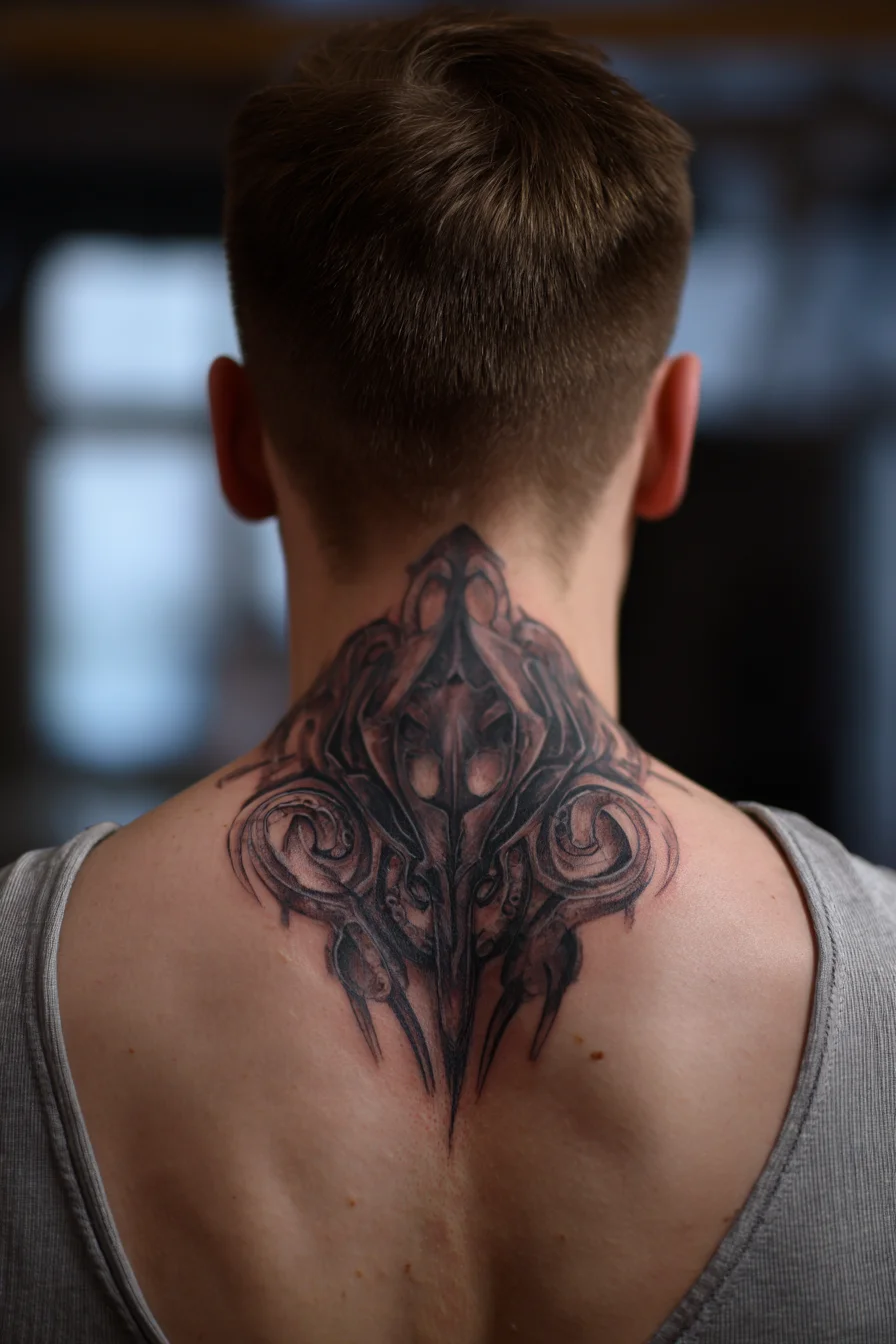
This bold, symmetrical nape-to-upper-back piece blends ornamental filigree with biomechanical shading to communicate strength, balance and transformation. The mirrored composition reads well as a protective chestplate or personal crest — a design that suits men looking for a strong central focal point rather than a discreet accent. Placement suggestions: center the design on the nape with the tip running down the spine and the wings spreading across the upper traps and between the shoulder blades for maximum anatomical impact. Pain expectations: the nape and spine are moderately to highly sensitive (thin skin and proximity to bone); expect sharper sensation near the vertebrae and less discomfort across fleshy traps. Size and session planning: keep this at least medium-large to preserve fine detail — roughly 12–20 cm (5–8 in) wide and 15–25 cm (6–10 in) tall is ideal; larger pieces will likely require multiple sessions. Styling variations: monochrome black-and-gray for a gritty, masculine look; heavier contrast and white highlights for pop; add color washes, dotwork halos, or extend into sleeves or chest panels for a cohesive full-back composition. Discuss layering and aftercare with your artist before booking.
Ornamental Blackwork Spine Tattoo — Filigree Back Piece
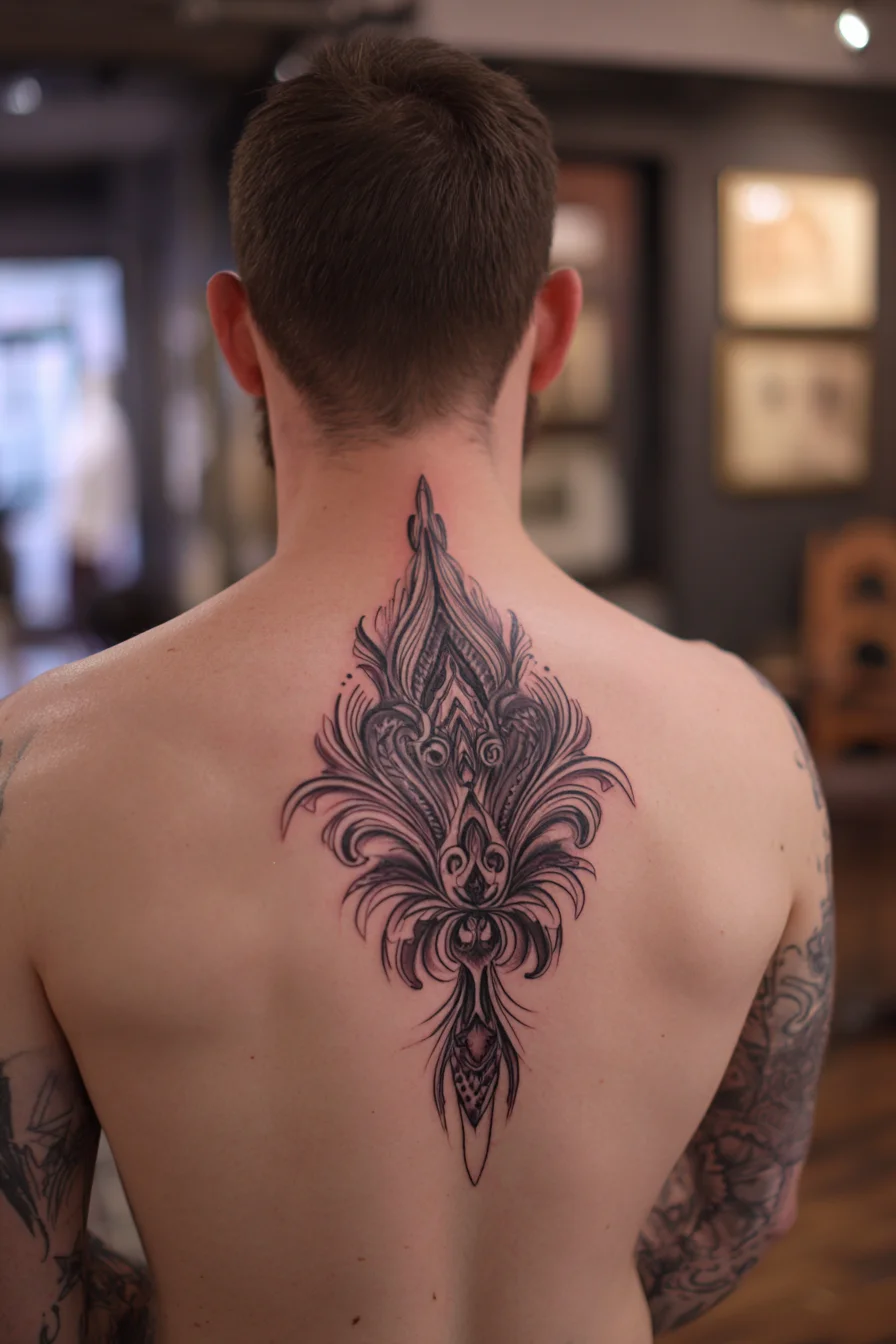
This vertical ornamental design reads as a modern filigree or fleur motif centered on the spine, symbolizing balance, inner strength, and personal refinement. The layered linework and negative-space detailing give it movement and a slightly masculine, architectural feel—good for men who want a statement piece without figurative imagery. Placement suggestions: centered down the upper-to-mid spine is ideal to follow natural anatomy; it can be extended upward toward the nape or downward toward the lower back depending on coverage goals. Pain expectations: expect moderate discomfort—muscular areas of the upper back are tolerable, while tattoos directly over the spine and near the neck feel sharper. Break the work into 1–3 sessions for client comfort. Size considerations: the design benefits from a medium-to-large scale so fine filigree remains legible; avoid shrinking below the artist’s minimum line-weight recommendation. Styling variations: translate the piece into bold blackwork for longevity, add dotwork shading for texture, introduce subtle color accents (deep reds or blues), or expand into shoulder/arm sleeves or a chest connector. Always discuss stencil placement and aftercare with your tattooist to ensure the best fit and healing.
Norse Knotwork Spine Backpiece — Tribal Blackwork Upper-Back Tattoo
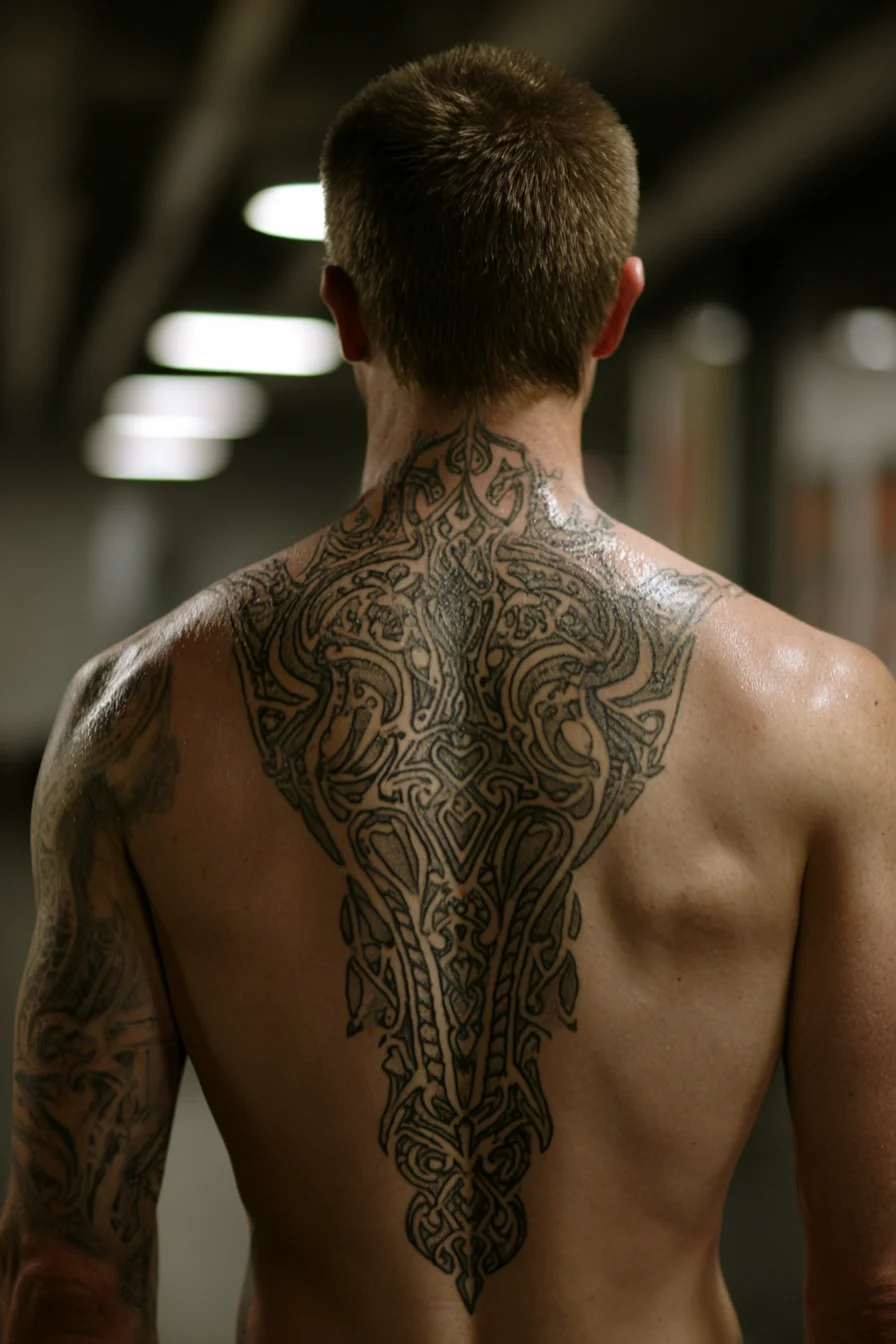
This bold Norse-inspired backpiece features intricate knotwork cascading from the nape down the spine — a design that reads as protection, resilience and interconnected paths. Ideal for men who want a statement-centered tattoo, it suits the upper back, follows the center line of the spine and spreads across the shoulder blades; it can be extended into sleeves or shoulder caps for continuity. Expect variable pain: the spinal column and back of the neck are more sensitive and can feel sharper over bone, while broader muscle areas like the scapula and upper traps are generally moderate. Large-scale coverage usually requires multiple sessions—plan shorter 2–4 hour sittings for comfort and optimal line work. Size matters: knotwork needs room for detail, so aim for a vertical piece of at least 10–14 inches to keep interlacing crisp; increase scale for finer lines or additional shading. Styling variations include pure blackwork, heavy shading for depth, dotwork textures, or selective color highlights. Consult an artist experienced in Nordic knotwork about stencil placement, line weight and a staged healing plan to ensure balance and longevity.
Symmetrical Dragon–Tentacle Full-Back Tattoo — Blackwork Mythic Backpiece
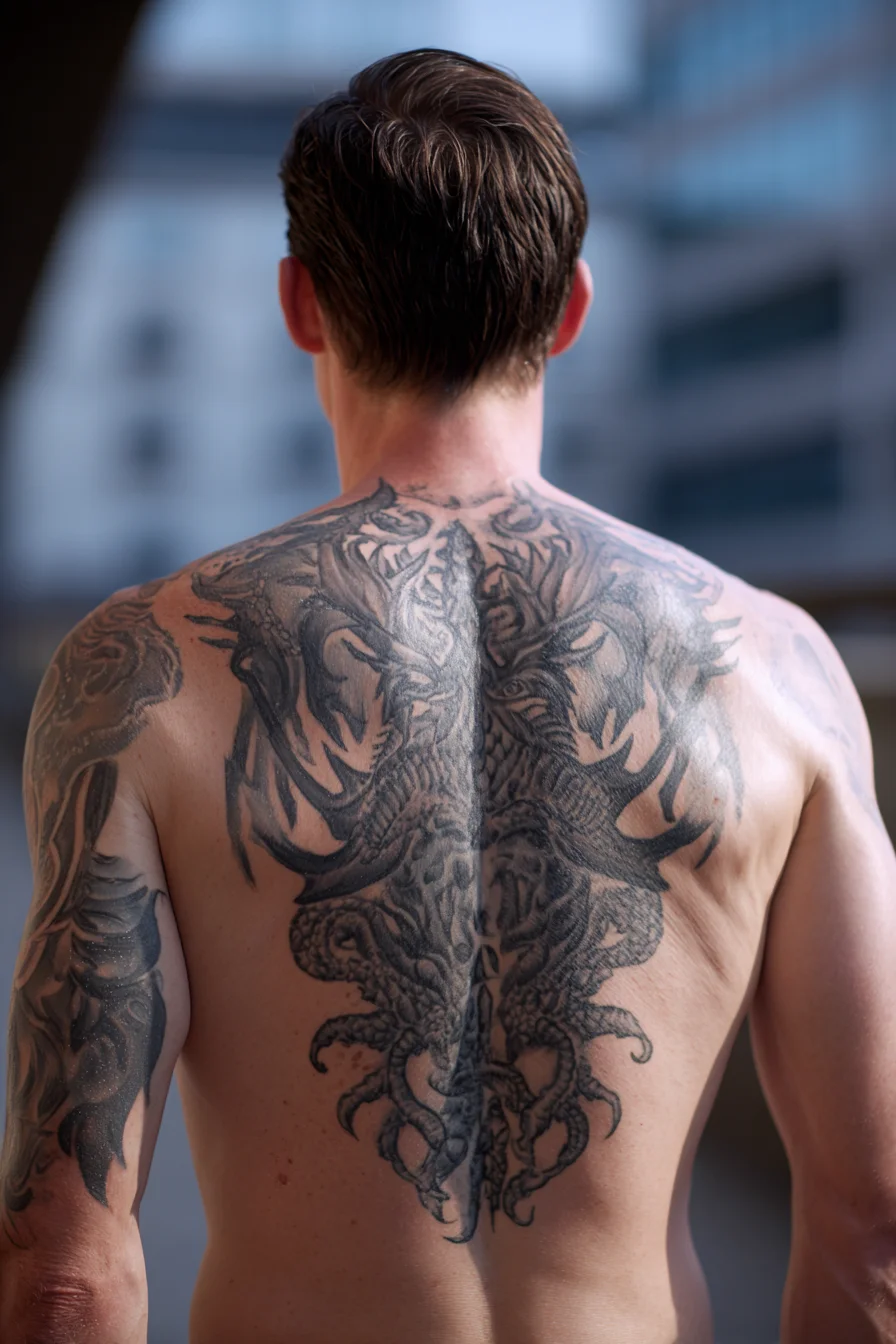
This full-back design blends dragon imagery with tentacled, cephalopod elements for a mythic, aggressive composition that reads well from a distance and holds detail up close. Meaningfully it pairs strength and protection (dragon) with adaptability and mystery (tentacles), a good choice for men wanting a bold statement about resilience and layered identity. Placement: ideal as a full-back or upper-back piece running down the spine, with natural extensions across the shoulders or wrapping slightly onto the triceps for a cohesive sleeve transition. Pain expectations: plan on moderate to high discomfort—shoulder blades and fleshy upper back are tolerable for most, while the spinal column and lower back near bone are more sensitive; several sessions of 3–5 hours is typical. Size considerations: the design benefits from large scale to preserve intricate linework and shading; scale down only by simplifying textures and removing tiny detail. Styling variations: blackwork or grayscale for a classic, masculine look; add dotwork or geometric negative-space for contrast; introduce selective color highlights (red, gold) sparingly to maintain impact. Ask your artist to orient lines with muscle flow for longevity and smoother healing.
Nape-to-Upper Back Viking Warrior Tattoo — Black & Gray Ship Portrait
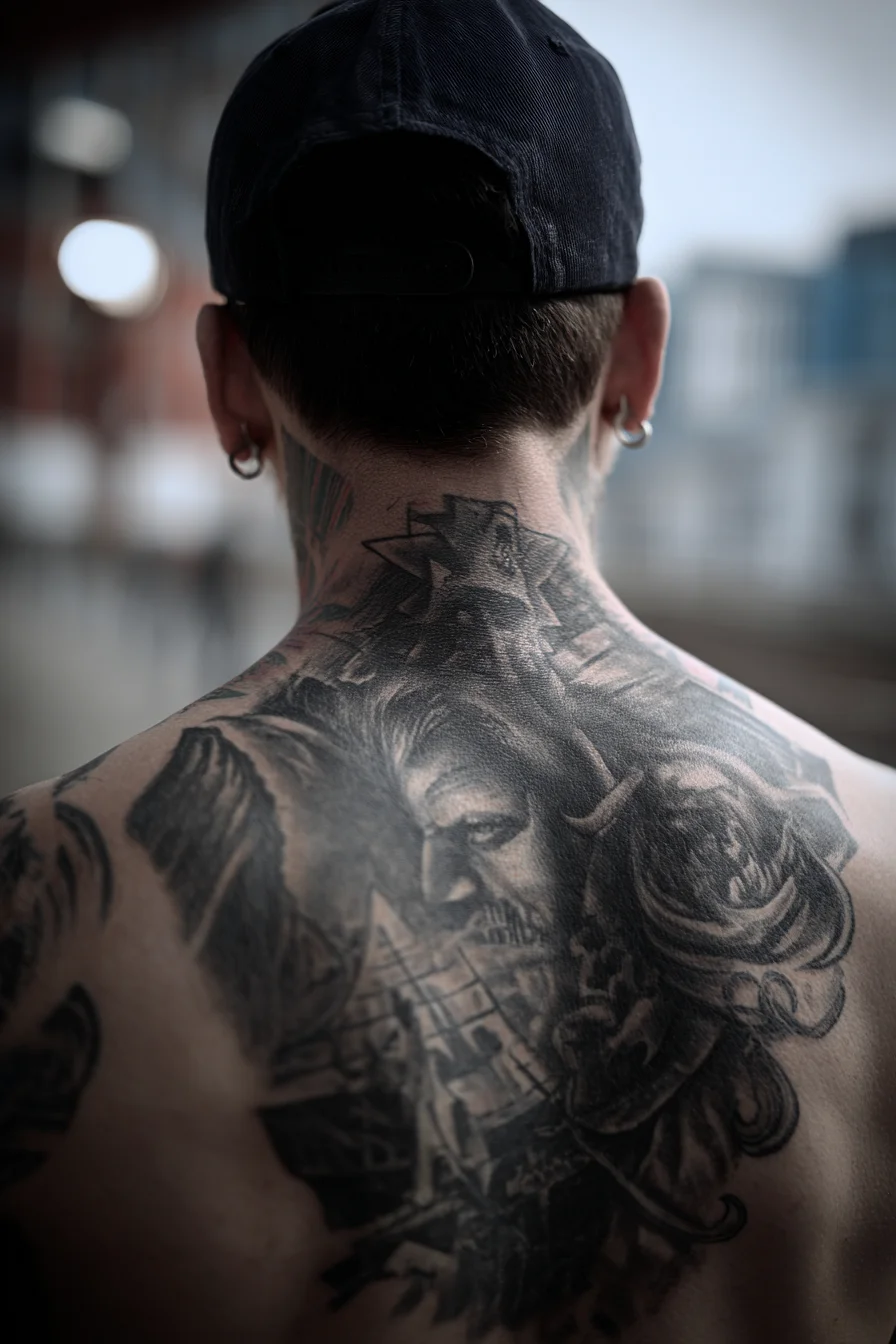
Bold black-and-gray back piece featuring a bearded warrior, ship and ornamental elements — ideal for men seeking a masculine, narrative design. Meaning: combines themes of strength, journey, and resilience; the warrior portrait reads as protection and leadership while the ship symbolizes risk, exploration and personal voyages. Placement: best as an upper-back or full-back canvas with elements flowing up the nape and across the shoulders; can be extended into a sleeve or neck piece for continuity. Pain: expect moderate to high discomfort at the nape and along the spine or shoulder blades; fleshy outer shoulders and mid-back are more tolerable. Size considerations: to preserve facial detail and rigging, plan for a large format (full or upper back). Smaller renditions lose fine shading and texture. Styling variations: black-and-gray realism emphasizes mood and contrast; add selective color (rust, deep blue) for focal points; consider dotwork backgrounds, bold neo-traditional outlines for longevity, or negative-space highlights to improve readability. Expect multiple sessions and strict aftercare to maintain tonal depth.
Winged Lion Black & Grey Back Tattoo — Lion, Wings & Ornamental Filigree
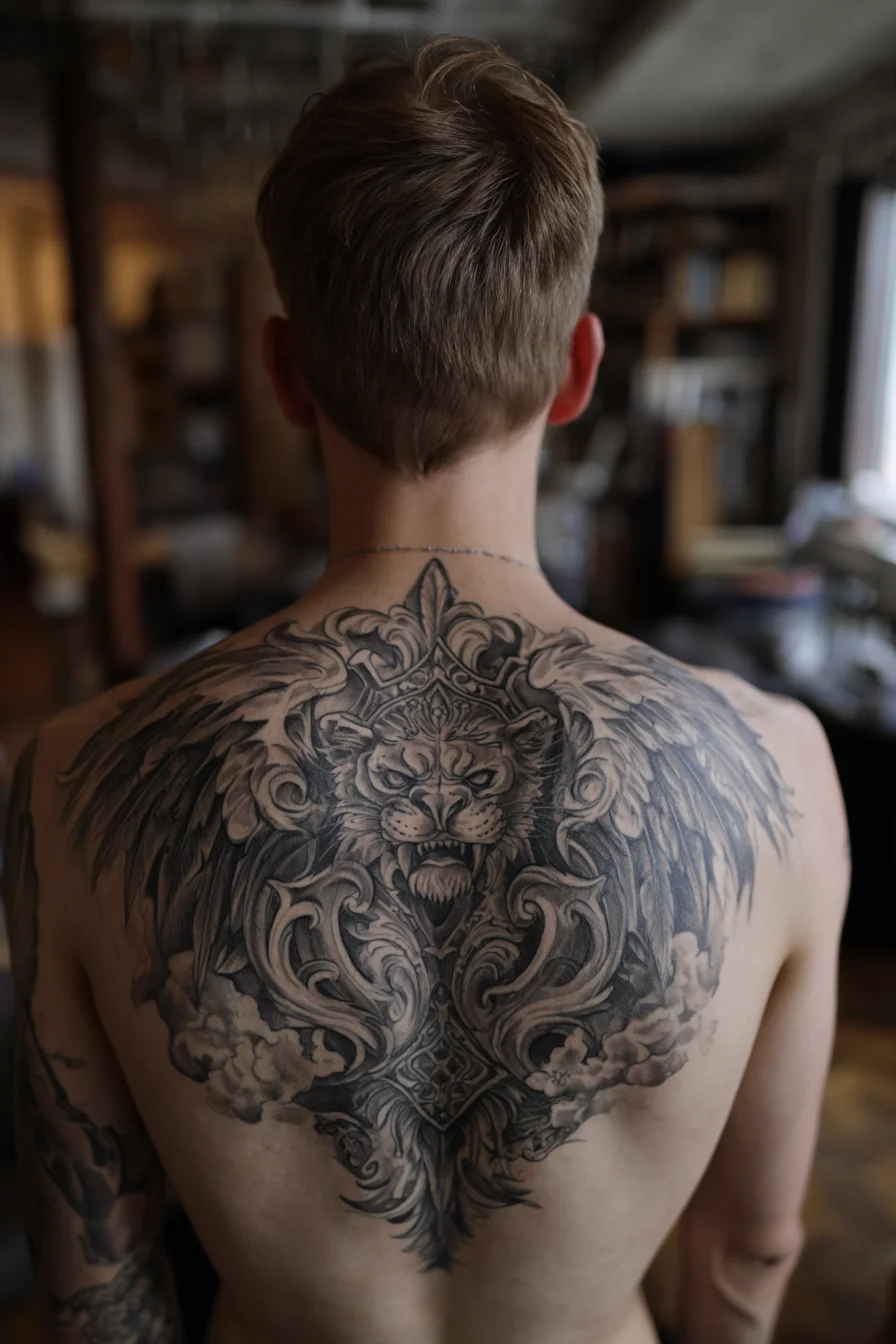
This dramatic black-and-grey backpiece combines a roaring lion, angelic wings and baroque filigree to communicate strength, leadership and protection with a noble, timeless feel. For men seeking a bold statement, the lion center symbolizes courage and authority while the wings add motion and a guardian or freedom motif. Placement suggestions: full upper-back or full-back is ideal to preserve scale and detail; the design also adapts to a centered chest piece, shoulder cap, or expanded sleeve if you prefer something smaller. Pain expectations: upper back muscle tissue is generally moderate in discomfort, but areas over the spine, shoulder blades and near ribs will be more sensitive — expect sharper sensations there. Size and session planning: to retain fine shading and ornamental detail this style typically requires a large canvas and multiple sessions (often 2–5 depending on coverage and detail). Styling variations: keep it pure black & grey realism, add selective color accents (gold, red) for contrast, or simplify into neo‑traditional linework, dotwork, or geometric/mandala integration for a modern twist. Discuss skin tone, aging and touch‑up plans with your artist before booking.
Ornate Dragon-Beast Full-Back Tattoo — Black & Grey Symmetrical Design
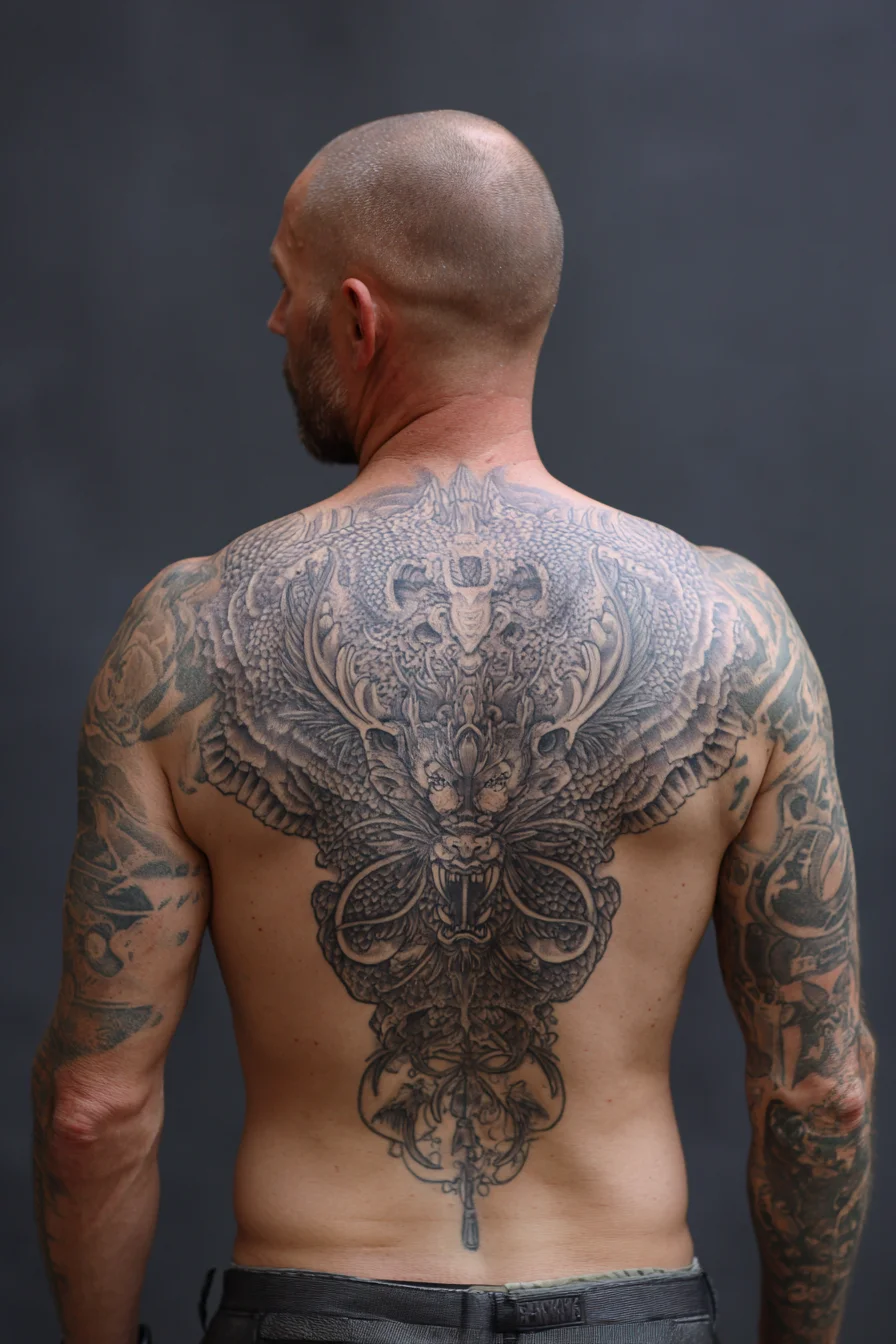
This imposing, highly detailed back piece combines mythic dragon and beast motifs with ornamental filigree to create a bold, masculine statement. Conceptually it communicates protection, strength, and controlled ferocity while using symmetry and texture to sit naturally across the shoulder blades and spine. Placement suggestions: ideal as a full-back centerpiece that can be extended across the shoulders, wrapped down the spine, or linked to chest and sleeve work for a cohesive torso composition. Pain expectations: back tattoos are generally low-to-moderate overall, but expect sharper sensitivity along the spine, shoulder blades, and near the ribs — plan shorter sessions near those zones. Size considerations: to retain the fine detail, keep this design large (full or upper back); scaling down will blur intricate linework and texture. Expect multiple sessions and 10–20+ hours depending on shading. Styling variations: strong black-and-grey realism, heavy blackwork for silhouette impact, selective color highlights (reds or golds) for focal points, or dotwork/ornamental fills for a more graphic look. Discuss flow with your artist to match muscle shape and existing tattoos, and follow aftercare for optimal healing and longevity.
Full-Back Black & Grey Tattoo — Japanese/Neo-Traditional Warrior & Skull Motif
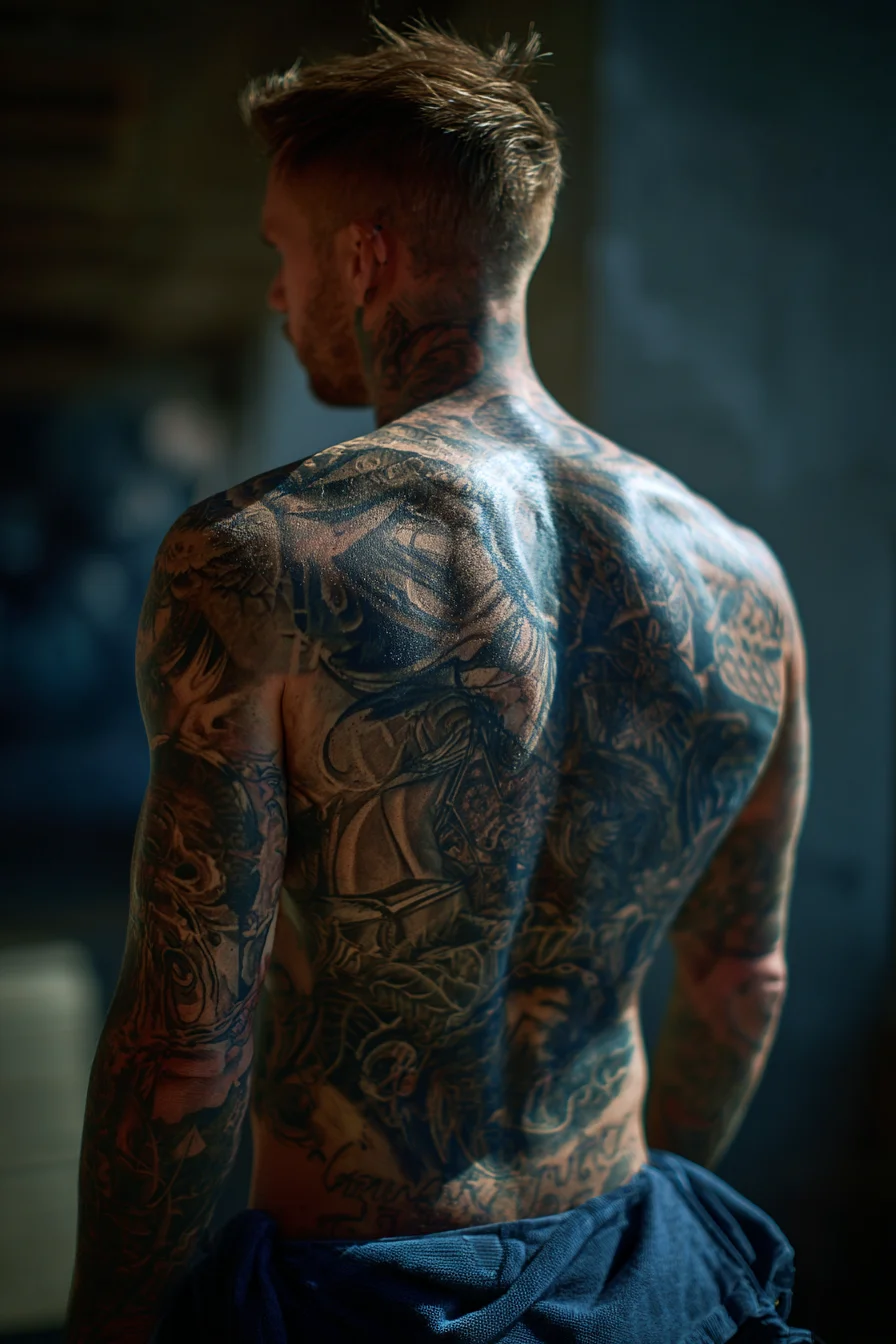
This full-back black & grey composition reads as a bold storytelling piece—warrior figures, skulls and organic elements combine to convey strength, resilience and transformation. As a statement for men, the design emphasizes masculinity through dynamic movement, contrast and large-scale anatomy mapping. Placement suggestions: a complete back piece is ideal for the full canvas, with natural extensions to the shoulders, neck nape and full sleeve work; for a lower-commitment option consider a half-back or upper-back panel. Pain level expectations: expect mixed sensations — the fleshy upper traps and shoulders are typically moderate, while the spine, ribs and lower back can be significantly more sensitive; long sessions may increase discomfort. Size considerations: a true full-back requires multiple sessions (often 10+ hours across several appointments) and careful planning for flow and negative space; half- or three-quarter layouts reduce time and cost. Styling variations: keep it black & grey for a classic, masculine look; add selective color highlights, dotwork backgrounds, or bolder Japanese linework for more contrast. Discuss session pacing, aftercare and how the piece will age with your artist before booking.
Full-Back Botanical Blackwork Tattoo — Leaves, Dotwork & Shading
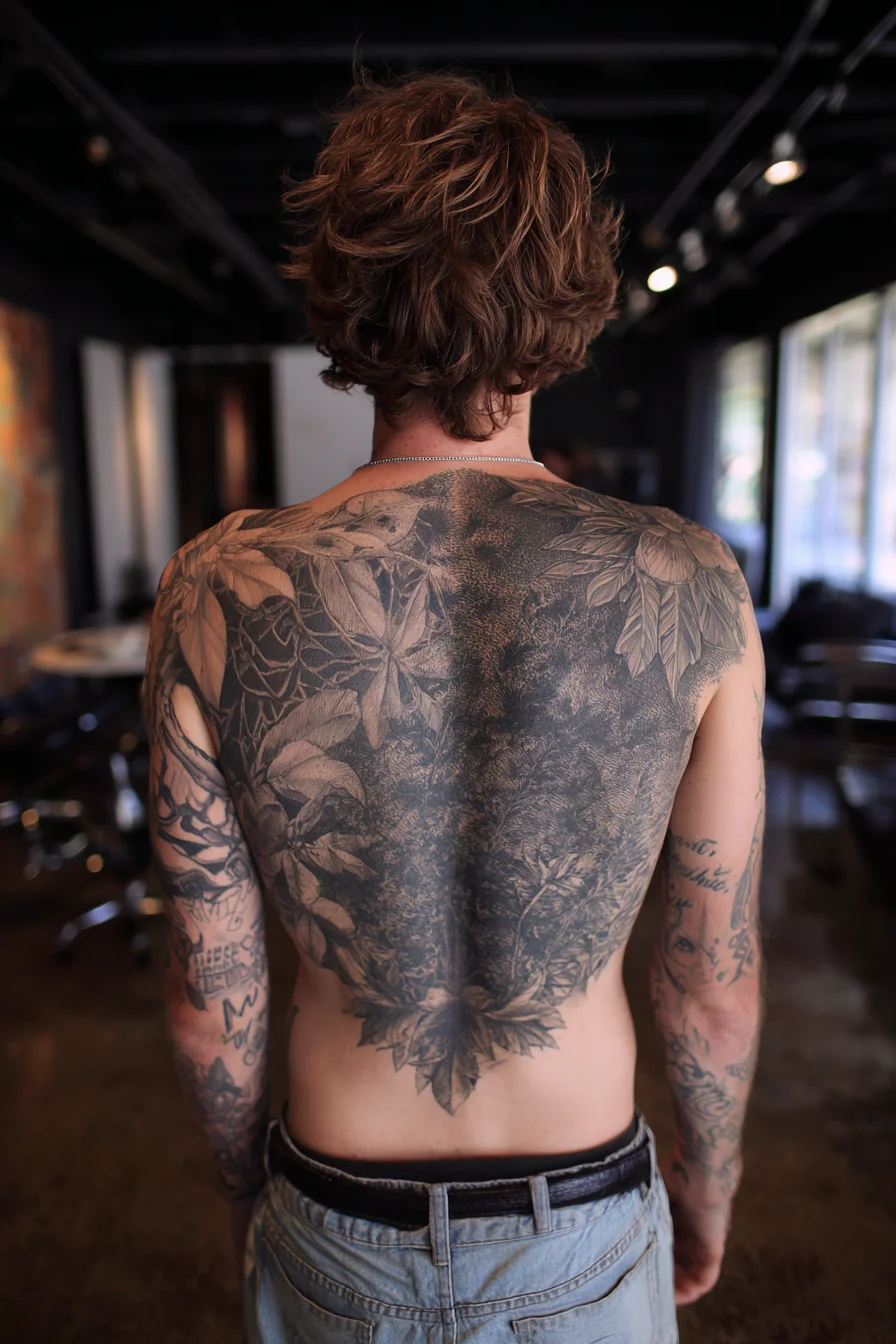
This full-back botanical blackwork piece uses dense dotwork, negative space and layered leaf motifs to convey themes of growth, resilience and grounded masculinity. The foliage wrapping the shoulders reads like natural armor, offering a bold statement without overt symbolism. Placement suggestions: ideal as a full-back centerpiece that can extend to the shoulders, upper arms or wrap slightly toward the chest and lower back; smaller adaptations work well as upper-back or shoulder-blade panels for less commitment. Pain expectations: the fleshy areas of the back are moderate in discomfort, but expect increased sensitivity along the spine, shoulder blades, ribs and tailbone—long sessions can be tiring, so plan multiple 3–5 hour appointments. Size considerations: large canvas is recommended to retain the fine dotwork and vein detail; reducing scale will sacrifice texture, so opt for at least a shoulder-width composition. Styling variations: keep it high-contrast blackwork for graphic impact, add muted greens or sepia washes for natural realism, or incorporate geometric frames/mandala elements to enhance symmetry. Healing typically takes 2–4 weeks with standard aftercare—choose an experienced blackwork artist and discuss session pacing and stencil placement to follow muscle lines.
Winged Spine Back Tattoo – Ornate Blackwork Warrior Design
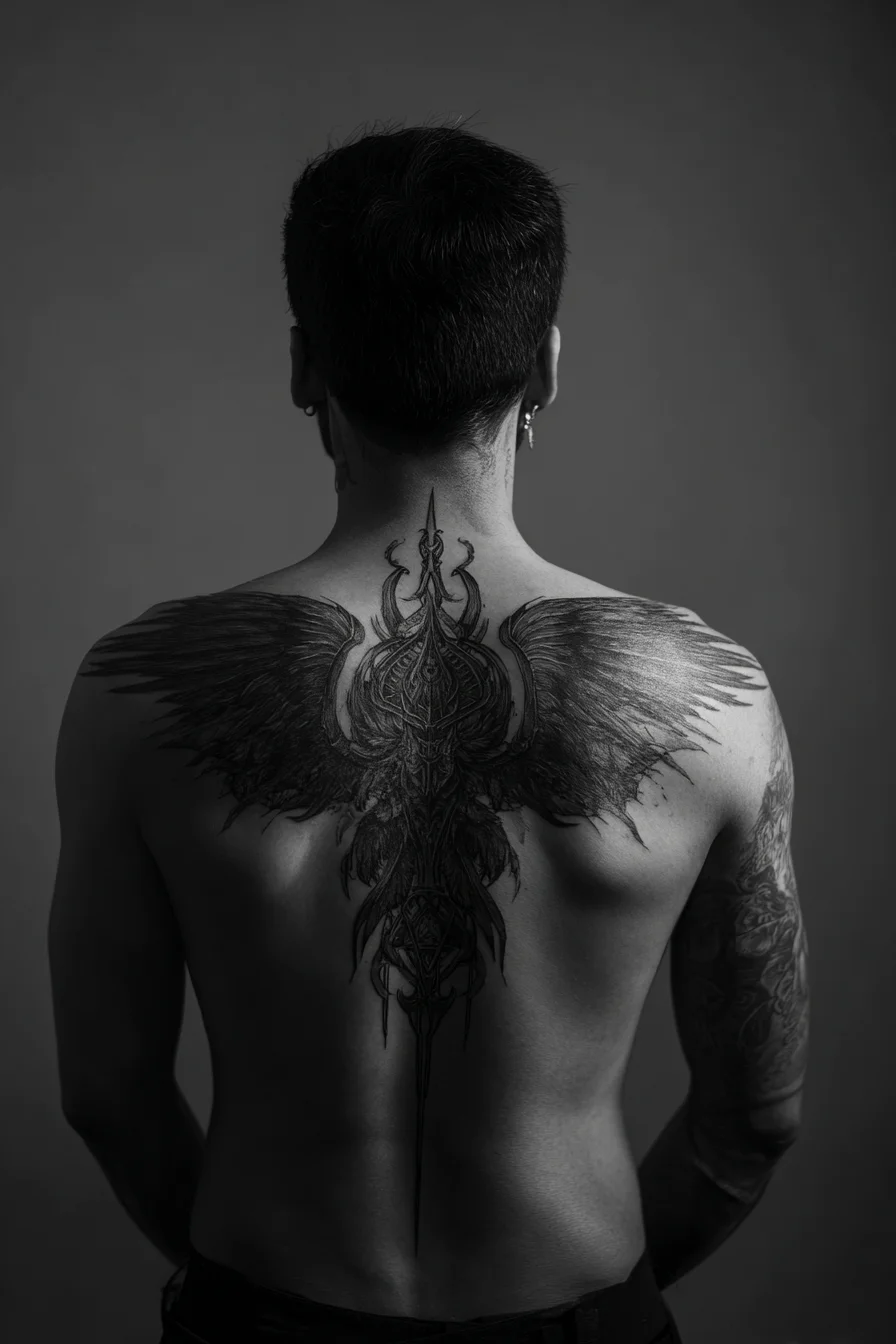
This bold back piece reads as a dark-angel/warrior emblem: symmetrical wings spread across the scapulae with an ornate, spear-like ornamental column running down the spine. Its visual language conveys protection, strength, transformation and a stoic, masculine presence — good for men who want an imposing centerpiece rather than a subtle accent. Placement suggestions: full upper-back across the shoulders with the central motif continuing down the thoracic spine; smaller options include a shoulder-blade-only spread or a half-back adaptation that tapers into the lat. Pain expectations: shoulder blade flesh and upper-back musculature are typically moderate in pain; the central spine and areas directly over bone will feel sharper and may require shorter sessions. Size considerations: detail-oriented blackwork benefits from a larger canvas — plan for a minimum width that spans both scapulae and a vertical length long enough to preserve fine linework; expect multiple sessions and a higher time/cost investment. Styling variations: heavy blackwork/graywash for a dramatic look, dotwork or geometric fills for texture, selective color accents (deep red or metallic tones) for contrast, or distressed edges/negative-space highlights for a weathered, aggressive finish. Consult your artist for stenciling to follow muscular flow and discuss session pacing and aftercare.
Viking Warrior Full-Back Tattoo — Black & Gray Realism Backpiece
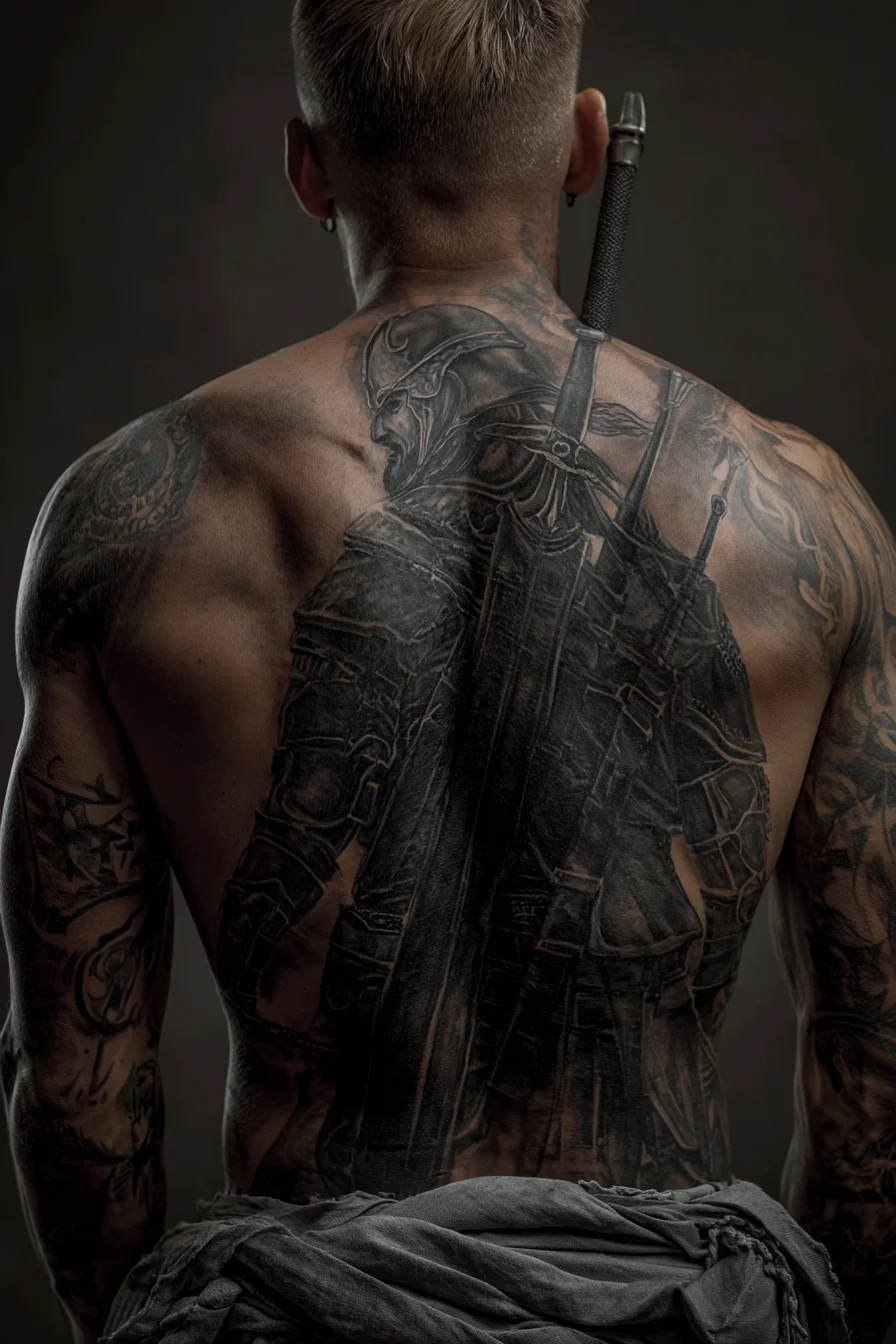
This full-back warrior tattoo channels themes of strength, honor, protection and resilience through a helmeted fighter and strapped swords — a classic motif for men wanting bold, narrative body art. As a backpiece it reads dramatically when centered on the spine and spanning the shoulder blades, or can be cropped to an upper-back panel if you prefer less coverage. Expect moderate to high pain: fleshy areas across the lower back are easier, while the spine, ribs and shoulder blades are more sensitive. Realistic detail and texture require a larger canvas — plan on a full-back layout (12–20+ inches) or multiple sessions for an upper/back-to-shoulder composition. Commission an experienced realism artist; fine line detail looks best at larger scales to avoid early blurring. Styling variations include pure black-and-gray realism, selective color accents (blood, metal highlights), a textured dotwork or geometric background for contrast, or an illustrative/neo-traditional rework for bolder outlines. Discuss session pacing, scar or skin-stretch considerations, and aftercare with your artist to ensure long-term clarity and placement that complements male musculature.
Full-Back Mandala Blackwork Tattoo — Ornamental, Floral & Geometric
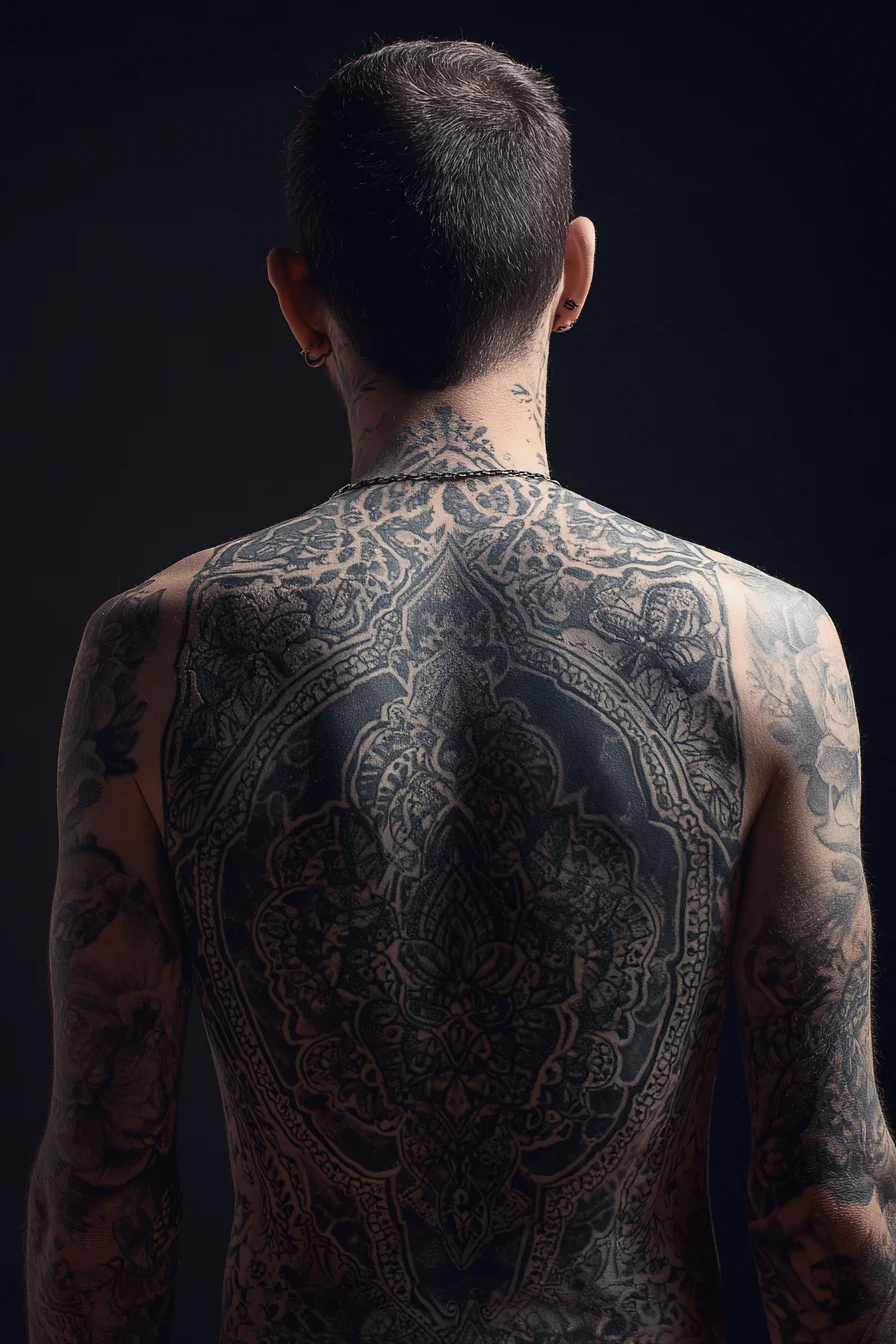
This is a large ornamental mandala rendered in bold blackwork with floral and geometric motifs — a design that commonly represents balance, protection, and personal transformation. It reads best as a centered full-back piece where the spine acts as the main axis and symmetry complements natural musculature. Placement suggestions: full back for maximum impact, upper-back panel if you prefer a shorter commitment, or shoulder and sleeve extensions to integrate with existing arm work. Pain expectations are moderate to high: fleshy areas (lower lats) are more tolerable, while the spine, scapula edges and ribs will be noticeably more painful. Expect multiple sessions (often 10–20+ hours) to complete heavy black fills and fine line detail; schedule healing time between sessions. Size considerations: keep the design large enough to preserve intricate patterns — scaling down will degrade clarity. Discuss negative space, contrast and skin tone with your artist. Styling variations for men include solid black silhouettes, dotwork shading, crisp geometric linework, or selective color accents on floral elements. For best results choose an artist experienced in symmetry and large-format composition.
Full-Back Tree of Life & Seascape Tattoo — Color Realism, Sunset Elements
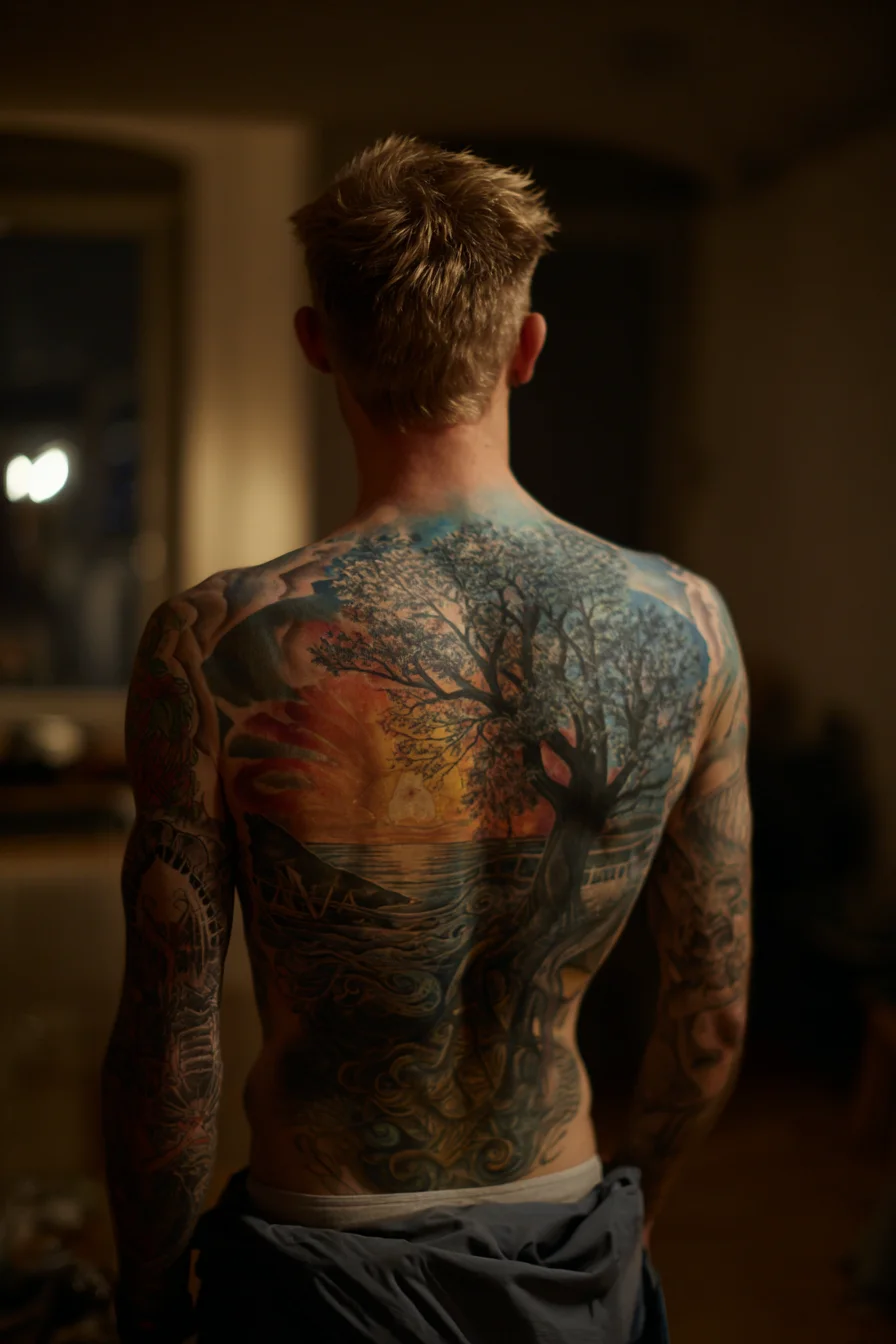
This full-back design combines a rooted tree silhouette with a sunset seascape, symbolizing resilience, personal growth, and life’s journey. The vertical trunk and spreading canopy create a strong central focal point while the horizon, water and boat details add narrative depth — ideal for men who want a bold statement piece with emotional symbolism. Placement suggestions: full back is the best canvas to preserve scale and flow; upper-back, shoulder-blade wrap or a rib-to-hip extension are good alternatives if you prefer segmented sessions. Pain expectations: expect moderate-to-high discomfort overall — fleshy areas of the lower back and outer ribs are more forgiving, while the spine, scapula and ribs register sharper sensations. Size considerations: this composition needs a large surface to maintain fine detail and color gradation; plan for multiple long sessions (often 10–30+ hours depending on complexity and color). Styling variations: adapt to black-and-grey realism, neo-traditional color, watercolor washes for the sky, or incorporate geometric and compass motifs for a nautical twist. Discuss contouring to muscle and future blending with sleeves when consulting your artist.
Choosing a back tattoo is an investment in time, money and personal expression. My professional advice: book an in-person consultation with an artist whose portfolio reflects the exact style you want, bring reference images (including these 32 curated examples), and ask for a life-size stencil to verify flow over your musculature. Break full-back projects into multiple sessions, be honest about your pain threshold, and allocate funds for quality ink and touch-ups. During healing, follow the artists aftercare: gentle cleansing, fragrance-free moisturizer, avoid submersion and direct sun, and sleep on a clean surface to reduce friction. Plan for how the piece will age — thicker lines and proper contrast maintain clarity longer. If you’re unsure, start with a smaller panel on the upper or lower back and expand later. If you have questions about placement, style matching, or artist selection, reach out — I’m Hakan and I’ll help you make a confident, lasting choice.
